How is the Cortile Barile series oven different from your other pizza oven kits?
Home > Refractory Materials > Full Size Fire Brick
Home > Refractory Materials > Full Size Fire Brick
Home > Refractory Materials > Full Size Fire Brick
Recommended Accessories for Cortile Barile • Package 3
9" x 4.5" x 2.5" fire brick straight
456 Fire Bricks per Pallet
7.65lb per fire brick
Full Pallet Orders Only
Pallet Size 36" x 48"
Pallet Weight - 50lb
Ocean Freight Wrap - No additional charge. Freight Delivery forum
Order Processing: 5 Business Days
Freight Delivery: 6-7 Business Days
Signature required delivery w/ Photo ID - No drop and go's...
2 phone numbers required for delivery
Firebrick is typically shipped no farther than 500 miles. For long-distance shipments, such as across the country, some bricks may arrive cracked. To minimize damage, the bricks are stacked carefully and tightly wrapped.
Fireproof Bricks - 3.6K
---
When you're building a pizza oven or brick fire pit, you need quality fire brick or refractory brick! We distribute America’s leading brands of fire brick, refractory brick, insulating firebrick & kiln bricks and deliver them directly to your home or business! Ensure the longevity of your refractory brick pizza oven or brick fire pit with high-quality medium-duty fire bricks that are manufactured to an exact 9” x 4.5” x 2.5”.
Are you planning on building a Fire Brick Pizza Oven?
Be sure to download our FREE Pizza Oven & Pizza Oven Base Installation Instructions and see why thousands of homeowners and professional masons choose BrickWood Ovens DIY Pizza Oven Kits when building their Outdoor Fire Brick Pizza Ovens! BrickWoodOns.com/pages/plans
Refractory Materials
Refractory materials (materials that can withstand high temperatures) are used in the construction and maintenance of ceramic studio kilns. Fire brick, ceramic fiber and castable refractories are the three forms of refractories used in kilns, but fire brick is the most significant.
A Brick with Many Faces
Fire brick is a generic term that encompasses any brick that can withstand repeated heating and cooling at various temperature ranges. Additionally, fire bricks must be able to withstand different atmospheres, provide various structural or insulating qualities, and due to the difficulty in cutting them, must be available in a variety of shapes to add flexibility to kiln design and construction.
Hard and Soft
There are two types of firebrick: hard brick and soft brick. Hard bricks are very dense and durable and used for their structural qualities. They can be found most often as the main building component of large kilns, chimneys, fireboxes and burner ports—anywhere around direct flame. Soft bricks are lightweight and made from a refractory clay body containing combustible materials. When fired, the materials burn out leaving a sponge like matrix of air pockets, which serve to provide insulating qualities to the brick. Also known as insulating firebricks (IFBs), these bricks absorb about half the energy as hard bricks during a firing. Soft brick ranges from 2000°F to 3300°F and are used as the brick of choice for constructing electric kilns or as insulating liners in reduction kilns.
Grades Are Important
The main ingredient in fire bricks is fireclay, which contains mostly alumina and silica, elements capable of withstanding high temperatures. Hard bricks are available in several grades, depending on their composition and properties, which determine the most efficient use of them in construction. High alumina compositions start at 50% alumina and increase in alumina content to 98% for the highest purity and most expensive. It’s extremely rare that a potter would require an alumina content exceeding 70%.
Low-duty: Typically rated to 1750°F maximum service temperature. Primarily used for fireplace chimneys and contains 24–26% alumina.
Medium duty: Temperature rating to 2700°F maximum service temperature. Uses include backup linings, lower-temperature ceramic kilns and chimneys, and contains 34–38% alumina.
High Duty: Temperature rating to 2850°F maximum in purely heat service. Certain atmospheres can reduce this temperature rating by several hundred degrees and contains 36–40% alumina. Uses include boilers, ceramic kilns, chimneys and back-up linings.
Super Duty: Temperature rating to 2900°F in pure heat service. Certain atmospheres can reduce this temperature rating by several hundred degrees. Same uses as high duty where higher temperatures are involved. Contains 40–44% alumina.
High-Fired Super Duty: Temperature rating between 3000°F–3150°F. A higher burned version of super duty firebrick designed to lower the porosity, increase physical strength and improve resistance to alkali attack and carbon monoxide disintegration. Contains 40–44% alumina.
Shapes
Most bricks are pressed or extruded. Common shapes are straights, arches, wedges, keys, rotary kiln blocks (RKBs) and square-edge tiles. Larger pieces are typically produced by air hammering the brick mix into wooden or steel molds sized for the desired shape dimensions.
The standard refractory brick size is 9×4½×2½ inches, also known as one brick equivalent (beq). This size is the most common used in pottery kiln construction. However, an equally popular standard size used in industrial furnace construction is the 9×4½×3-inch series. The 3-inch series brick reduces the number of joints in the kiln.
Straights - The standard straight is 9×4½×2½ inches or 9×4½×3 inches and available in larger sizes up to 18 inches long, 9 inches wide, and 4½ inches thick.
Splits - A term used to describe the thickness of a brick thinner than 2½ inches, i.e., splits come in 1, 1¼, 1½, and 2-inch thicknesses.
Square edge tile - This term refers to “big” straights, which comprise 12×12 inches up to 24×12 inches with thickness ranging from 1½ to 3 inches.
Soaps - A term used to describe a half brick in width such as 9×2¼×2½ inches or 9×2¼×3 inches.
Arch - This shape tapers in thickness along the width over its entire length and is used to make sprung or circular barrel arched roofs either 4½ inches or 6 inches in thickness.
Wedge - This shape tapers in thickness along the entire length of the brick and is used to make sprung or circular barrel arches 9, 12 or 13 inches in thickness.
Skew - A shape having a certain taper on one side or end to enable a sprung arch to be built. Four major types are available in both side and end skews that relate to the rise of the arch.
Fire Brick vs. Refractory Brick
What is Fire Brick
Features of Fire Brick
How Fire Bricks are Made
Difference between a Fire Brick and a..
Types of Fire Brick (Insulating Fire Brick)
Fire Brick Grades
Fire Brick Sizes
Fire Brick Shapes
Fire Brick Color
Fire Brick Stain
Fire Brick Manufacturers
Fire Brick Near Me
Fire Brick For Sale
Ordering Fire Brick & Delivery Options
How to Cut Fire Brick
How to Replace a Fire Brick
Fire Brick Mortar
Fire Brick FAQ’s and Knowledge
Fire brick and Refractory Brick
What you need to know before purchasing refractory brick
Most common:
“full size”
9” x 4.5” x 2.5”
456 brick per pallet
Lb per brick
A brick with many faces
Fire brick is a generic term that encompasses any brick that can withstand repeated heating and cooling at various temperature ranges. Additionally, fire bricks must be able to withstand different atmospheres, provide various structural or insulating qualities, and due to the difficulty in cutting them, must be available in a variety of shapes to add flexibility to kiln design and construction.
What is firebrick and why use it for the oven floor?
The word firebrick has no universal, specific definition we can site; you will find it used in conjunction with words like refractory and fire clay. Generally speaking, all of these terms are used to describe materials with the ability to withstand very high heat without falling apart.
One confusing thing about defining a firebrick is that the term has been used to describe different materials for various uses. For our purposes, we will concentrate on the nature of a modern firebrick and why it is the material of choice for a pizza oven floor.
What is fire brick
How are fire bricks are made
Why fire bricks able to sustain such high temperatures
What is a firebrick, and why do i need it for my pizza oven?
Firebrick is a heat-resistant brick that is used for creating fires. In essence, when you build a fire in your pizza oven, the bricks absorb the heat from the wood and coal and radiate it back to your meal/pizza.
Fire brick is a generic term that encompasses any brick that can withstand repeated heating and cooling at various temperature ranges. Additionally, fire bricks must be able to withstand different atmospheres, provide various structural or insulating qualities, and due to the difficulty in cutting them, must be available in a variety of shapes to add flexibility to kiln design and construction.
Refractory materials (materials that can withstand high temperatures) are used in the construction and maintenance of ceramic studio kilns. Fire brick, ceramic fiber and castable refractories are the three forms of refractories used in kilns, but fire brick is the most significant.
Retain heat better + release heat slower
because fire bricks are better for retention of heat it means you dont have to keep stocking up the fire and can use less wood in the long term. Another great feature is that the heat is released more evenly and slower meaning that you are less likely to flash burn breads, pastries, pizza bases etc.
Fire bricks, also called refractory bricks or alumina bricks, are bricks or shapes which can withstand high temperatures (up to 1800 deg c) without any deformation or fusion.
Refractory bricks are ceramic materials and can withstand very high temperatures without breaking or warping. Firebricks are an improved version of bricks designed for cooking at high temperatures.
Withstand heat to a higher temperature than normal bricks
While ‘normal’ bricks can withstand quite high temperatures, they do vary widely. With fire bricks you can be sure that your bricks aren’t going to crack or become brittle with on-going use. If bricks start cracking it can mean having to replace bricks, or worse, replace entire sections of the oven can become very costly, very quickly.
A fire brick, firebrick, fireclay brick, or refractory brick is a block of ceramic material used in lining furnaces, kilns, fireboxes, and fireplaces. A refractory brick is built primarily to withstand high temperature, but will also usually have a low thermal conductivity for greater energy efficiency. Usually dense fire bricks are used in applications with extreme mechanical, chemical, or thermal stresses, such as the inside of a wood-fired kiln or a furnace, which is subject to abrasion from wood, fluxing from ash or slag, and high temperatures. In other, less harsh situations, such as in an electric or natural gas fired kiln, more porous bricks, commonly known as "kiln bricks", are a better choice.[1] they are weaker, but they are much lighter and easier to form and insulate far better than dense bricks. In any case, firebricks should not spall, and their strength should hold up well during rapid temperature changes.
In the making of firebrick, fire clay is fired in the kiln until it is partly vitrified. Fire brick was first invented in 1822 by william weston young in the neath valley of wales.
98% of firebricks on the market are tan / buff in color, but sometimes a dealer will stock a different color like red or ivory. The color of the firebrick has absolutely zero effect on the performance of the oven. Besides… in a few weeks and after smoking a few briskets, they are all going to be black.
Purchase an additional 10 fire bricks for long term storage. If a brick should ever break, simply remove the broken fire brick and replace it with one of the new bricks. Do not replace a brick with a hairline crack! They are okay.
Refractory fire bricks
https://www.vitcas.com/refractory-fire-bricks
A fire brick is a block of refractory ceramic material used in lining furnaces, kilns, fireboxes, and fireplaces. A refractory brick is designed mainly to withstand high heat, but should also usually have a low thermal conductivity to save energy. Usually dense bricks are used in applications with extreme mechanical, chemical, or thermal stresses, such as the inside of a wood-fired kiln or a furnace, which is subject to abrasion from wood, fluxing from ash or slag, and high temperatures. Dense refractory bricks have a high thermal mass which is sometimes a useful property in that they will retain heat eg in a pizza oven after the fire has been taken out. Kiln bricks are made by firing a clay based composition in the kiln until it is partly vitrified, and for special purposes may also be glazed. Refractory bricks usually contain 30-40% alumina and the primary raw material is usually chamotte with other materials. The maximum service temperature increases with increasing alumina content and kiln bricks can be obtained with an alumina content of 80% and above.
Firebrick, also called refractory brick, refractory material consisting of nonmetallic minerals formed in a variety of shapes for use at high temperatures, particularly in structures for metallurgical operations and glass manufacturing. Principal raw materials for firebrick include fireclays, mainly hydrated aluminum silicates; minerals of high aluminum oxide content, such as bauxite, diaspore, and kyanite; sources of silica, including sand and quartzite; magnesia minerals, magnesite, dolomite, forsterite, and olivine; chromite, a solid solution of chromic oxide with the oxides of aluminum, iron, and magnesium; carbon as graphite or coke; and vermiculite mica. Minor raw materials are zirconia, zircon, thoria, beryllia, titania, and ceria, and other minerals containing rare-earth elements.
Firebricks are formed by the dry-press, stiff-mud, soft-mud casting, and hot-pressing processes used in the manufacture of building bricks. Some materials, including magnesite and dolomite, require firing in rotary kilns to bring about sintering and densification before the crushed and sized material can be fabricated into refractory shapes and refired. Raw materials are fused in an electric furnace followed by casting of the melt in special molds.
What makes them sustain high temperatures?
What makes them sustain high temperatures?
The life and temperature limit it can withstand depends upon various physical and chemical properties. These properties are alumina, iron, compact crushing (ccs), and flexural strength.
Alumina: higher the alumina content, the higher the operating temperature of the fire bricks will be. At refmon, we manufacture fire bricks with alumina content ranging from 35% to 80%.
Iron: lesser the less iron content, the higher the life of the bricks will be. Refmon fire bricks manufacture with as little as 2% iron content.
Compact crushing strength (ccs): the higher the ccs of the fire bricks, the better its performance.
Flexural strength: the higher the flexural strength, the higher is the load-bearing capacity of the bricks at high temperatures.
Refractory materials
Refractory materials (materials that can withstand high temperatures) are used in the construction and maintenance of ceramic studio kilns. Fire brick, ceramic fiber and castable refractories are the three forms of refractories used in kilns, but fire brick is the most significant.
Composition of firebrick
Clay is made up of various fine-grained rock materials and formed over long periods of time in the ground. Natural materials like alumina, silica and kaolinite, can give clay refractory qualities – the ability to withstand high heat. When clay is high in alumina, silica and kaolinite, it is called fire clay.
The first firebricks were simply fire clay dug from the earth, pressed and fired in a kiln. Industry, looking for improvements, started adding minerals to create mulite and silliminite in the body of the brick with iron and calcium being common ingredients.
Today firebricks share a specific process and grading scale to designate the characteristics and service duty of the brick. The fire clay and other materials need to reach a temperature that will melt them together. That bonding process is called sintering and is defined as the process of compacting and forming a solid mass of material by heat and pressure without melting it to the point of liquefaction.
How fire bricks are made
How are fire bricks made - refractory fire bricks manufacturing process
These fire bricks are made from plastic and non-plastic fire clays, bauxite, and grog.
The raw materials are mixed in fixed ratios and then ground to the desired size in a grinding unit.
This ground material is then mixed with water in a muller or u-mixer.
That ground semi-solid material is then pressed in friction presses for the desired shape.
They are then left at atmospheric temperature for 2-3 days for drying. Once dried, they are placed on trolleys and sent to the tunnel kiln for firing.
They are fired at a temperature of 1200 deg c and above. The process of firing takes about 48 hrs. Once fired, they are cooled and then removed from the trolleys. These bricks are now ready for dispatch.
The sintering process
Mix water, binder, unfired materials, clay and additives
Place in mold and press under approximately 8000 psi
Fire at a low temperature to burn off binder
Fire at approximately 3000˚f to fuse particles together
It is important to know that this sintering process reduces porosity and enhances strength and thermal conductivity to create the very nature of a firebrick.
The factors we pay the most attention to are:
Strength and temperature ratings
Thermal conductivity
Porosity
Abrasion resistance
Composition of firebrick
Clay is made up of various fine-grained rock materials and formed over long periods of time in the ground. Natural materials like alumina, silica and kaolinite, can give clay refractory qualities – the ability to withstand high heat. When clay is high in alumina, silica and kaolinite, it is called fire clay.
The first firebricks were simply fire clay dug from the earth, pressed and fired in a kiln. Industry, looking for improvements, started adding minerals to create mulite and silliminite in the body of the brick with iron and calcium being common ingredients.
Today firebricks share a specific process and grading scale to designate the characteristics and service duty of the brick. The fire clay and other materials need to reach a temperature that will melt them together. That bonding process is called sintering and is defined as the process of compacting and forming a solid mass of material by heat and pressure without melting it to the point of liquefaction.
Diy fire brick
So, you watched a couple of youtube videos on making diy fire brick and now you’re ready to start saving some money by spending hours of your valuable time making fire brick from the youtubers list of ingredients like river clay, broken glass shards, straw and/or vermiculite / perlite.
How to make fire brick
Castable refractory - refractory cement | castable refractory cement at the lowest prices! – brickwood ovens
Features of a fire brick • what to look for
· Very dense / solid
· 7 lbs
· How to tell if a brick is a fire brick - (what to look for)
They can withstand high temperatures.
They have low thermal conductivity.
They have low water absorption.
They are somewhat chemically resistant.
They are available in various shapes, sizes, and grades.
Properties of fire bricks
They are yellowish white or white in color.
They are available in different sizes ranging from 9 x 4.5 x 2.5 inches to 9 x 2.75 x 2.25 inches.
One general fire brick weighs about 30 to 35 n.
The compressive strength of fire bricks ranges from 200 to 220 kg/cm2.
The percentage of water absorption varies from 5 to 10%.
They have good chemical resistance.
If you are looking to buy fire bricks for your pizza oven, you should keep a few things in mind:
Make sure that the bricks are made explicitly for high-temperature cooking.
Be sure to check the size and thickness of the brick before purchasing.
Difference between a fire brick and a..
a. Refractory brick
b. Clay fire brick
c. Clay brick - fire brick vs regular brick
d. Concrete brick
While ‘normal’ bricks can withstand quite high temperatures, they do vary widely. With fire bricks you can be sure that your bricks aren’t going to crack or become brittle with on-going use. If bricks start cracking it can mean having to replace bricks, or worse, replace entire sections of the oven can become very costly, very quickly.
Bricks that are not explicitly made for high-temperature cooking should not be used as fire bricks. These bricks may not withstand the heat and can crack or break, causing damage to the oven.
When constructing a pizza oven, it is essential to use a brick labeled as fire brick. This will ensure that your range is safe to use and will last for many years!
Can i use regular bricks for a pizza oven?
No, it would help if you did not use regular bricks for a pizza oven. They will not withstand the high temperatures and may break or warp. Refractory bricks are made of ceramic material specifically designed for this purpose.
If you are in the process of building your oven, the condition of these bricks will also determine how long your pizza oven lasts. A brick that is not fire-resistant will crack easily when exposed to high temperatures over time. This means you need to make sure that you purchase refractory bricks for maximum longevity in your oven. In short, fire bricks are an essential part of your pizza oven setup. They help create and distribute heat evenly, making for a better cooking experience.
When purchasing them, make sure to get refractory bricks if you want them to last long term.
Refractory bricks are the best type to use for a pizza oven. They are made of ceramic material and can withstand high temperatures without breaking or warping.
Red clay bricks are fired at 1200° and can withstand the high temperatures. But what they can not tolerate is the rapid temperature change experienced inside a wood-fired oven. They will eventually experience spalling, which is the cracking and flaking that occurs during thermal shock (rapid heating / cooling / heating / cooking)… and that flaking can end up in your food. And after a while, the bricks will start to crumble and fall apart.
Secondly – red clay fire bricks are very, very fragile when compared to fire brick. They break and crack very easily.
If you are in the process of building your oven, the condition of these bricks will also determine how long your pizza oven lasts.
A brick that is not fire-resistant will crack easily when exposed to high temperatures over time. This means you need to make sure that you purchase refractory bricks for maximum longevity in your oven.
In short, fire bricks are an essential part of your pizza oven setup. They help create and distribute heat evenly, making for a better cooking experience.
When purchasing them, make sure to get refractory bricks if you want them to last long term.
How can you tell if a brick is fire brick?
A fire brick should have a label that states its chemical makeup. This is important because it will identify if the brick is made of insulating materials or just ceramic material. If you cannot find this information, it would be best to contact the manufacturer for more details.
Are you planning on building a fire brick pizza oven?
Be sure to download our free pizza oven & pizza oven base installation instructions and see why thousands of homeowners and professional masons choose brickwood ovens diy pizza oven kits when building their outdoor fire brick pizza ovens!
Brickwoodovens.com/pages/plans
Types of fire brick / fire brick grades
There are two types of firebrick: hard brick and soft brick. Hard bricks are very dense and durable and used for their structural qualities. They can be found most often as the main building component of large kilns, chimneys, fireboxes and burner ports—anywhere around direct flame. Soft bricks are lightweight and made from a refractory clay body containing combustible materials. When fired, the materials burn out leaving a sponge like matrix of air pockets, which serve to provide insulating qualities to the brick. Also known as insulating firebricks (ifbs), these bricks absorb about half the energy as hard bricks during a firing. Soft brick ranges from 2000°f to 3300°f and are used as the brick of choice for constructing electric kilns or as insulating liners in reduction kilns.
How long do fire bricks last? Life expectancy?
Fire bricks can last for many years if used and stored correctly. It is essential to remember that they may not withstand as much heat over time and may eventually crack or break. Always test out a small area before using an entire brick to ensure it is still in good condition!
Hard fire brick – descriptive sentence
· High duty
· Medium duty (pizza oven preferred)
· Super duty
· Super duty high fired
Soft fire brick – descriptive sentence
Insulating fire brick (260) – descriptive sentence (while these types are fire brick are never used, we can briefly touch on these types of brick). Soft fire brick (170) / insulated fire brick (210)
· 2300 ifb
· 2600 ifb
· 2800 ifb
· 3000 ifb
Industrial firebrick grading system - grades are important
The main ingredient in fire bricks is fireclay, which contains mostly alumina and silica, elements capable of withstanding high temperatures. Hard bricks are available in several grades, depending on their composition and properties, which determine the most efficient use of them in construction. High alumina compositions start at 50% alumina and increase in alumina content to 98% for the highest purity and most expensive. It’s extremely rare that a potter would require an alumina content exceeding 70%.
Low-duty: typically rated to 1750°f maximum service temperature. Primarily used for fireplace chimneys and contains 24–26% alumina.
Medium duty: temperature rating to 2700°f maximum service temperature. Uses include backup linings, lower-temperature ceramic kilns and chimneys, and contains 34–38% alumina. This is the preferred fire brick for pizza ovens. Great general purpose highest quality medium duty firebrick used for pizza ovens, pottery kilns, fireplaces and temperatures less than 2000f/1200c. Medium duty fireplace brick conforms to astm specifications c-27 – class 4.1.4 and 4.1.5 for medium duty and low duty respectively and c-1261-98 (which includes c-24 and c-67), as well as, c-16, c-20, c-24, c-38, c-113, c-133.temperature use limit of 2700 f. Good for fireplaces, bread and pizza ovens, kiln chimneys and back-up linings. This general purpose high-duty firebrick can be used for boilers, pottery kilns, backup linings, anywhere you need moderate temperature protection.
· High duty (first-quality firebrick): temperature rating to 2850°f maximum in purely heat service. Certain atmospheres can reduce this temperature rating by several hundred degrees and contains 36–40% alumina. Uses include boilers, ceramic kilns, chimneys and back-up linings. The vast majority of pottery kilns are constructed of high duty or super duty brick. Temperature use limit of 2850 f. Recommended for high heat, low abrasion applications including boilers, furnaces, kiln sidewalls, arches and floors where the brick will have only one hot face. High duty products provide cost-effective alternatives for a variety of applications. High firing of both types of fireclay brick improves hot strengths, resistance to carbon monoxide attack and disintegration.
super duty - temperature rating to 2900°f in pure heat service. Certain atmospheres can reduce this temperature rating by several hundred degrees. Same uses as high duty where higher temperatures are involved. Contains 40–44% alumina. The higher duty firebrick will increase strength, thermal conductivity and abrasion resistance but lose porosity. Manufacturers adhere to iso certified standards but the actual formulations are proprietary. For example, thermal ceramics offers 10 formulas for dense firebricks that can reach 90+ % alumina content. So what brand x calls medium duty may be considerably different than brand y.
Temperature use limit of 2910 f. Recommended for high heat, medium abrasion applications including boilers, furnaces, arches, floors and kiln fireboxes, bag walls and posts where the brick may have more than one hot face. The super duty brands offer excellent spalling resistance
high fired super duty - temperature rating between 3000°f–3150°f. A higher burned version of super duty firebrick designed to lower the porosity, increase physical strength and improve resistance to alkali attack and carbon monoxide disintegration. Contains 40–44% alumina. Very dense, high strength, super-duty fireclay brick. Modulus of rupture 900-1600 psi. Temperature use limit of 2910 f. Twice fired and recommended for high heat, high abrasion applications including boilers, furnaces, arches, floors and other applications where continuous abrasion is anticipated.
Insulating fire brick
In this next (short) section, we are going to briefly discuss insulating fire brick. These types of bricks are not recommended for fire brick pizza ovens – click here to skip this section entirely and jump to the next section.
Insulating fire brick (260) – descriptive sentence (while these types are fire brick are never used, we can briefly touch on these types of brick). Soft fire brick (170) / insulated fire brick (210)
· 2300 ifb
· 2600 ifb
· 2800 ifb
· 3000 ifb
Insulating fire brick – can also be called soft fire brick
Insulating fire brick (ifb) for use in applications from 2300 °f (1260°c) to 3200°f (1760°c). Insulating fire brick is made from high purity refractory clays and other ceramic raw materials.
This type have low thermal conductivity and low heat storage properties. They may be used as the hot face layer or as backing insulation for dense bricks. Insulation fire bricks occur in range from grade 23 to grade 32
The light fire bricks 1430 °c/2606 °f and 1650 °c/3002 °f can easily be brought into the desired shape with a saw, a rasp or sand paper. Light fire bricks 1800 °c/3272 °f can be easily processed with an angle grinder with a diamond disc.
Light fire bricks are suitable for a variety of applications. Unlike normal firebricks, they only absorb little energy (heat) but radiate it again. This significantly increases the efficiency of gas fires or melting furnaces, gas consumption decreases and the achievable temperature increases. The warm-up time is also drastically reduced.
While insulating firebricks can be easily cut with any kind of saw
Soft bricks are lightweight and made from a refractory clay body containing combustible materials. When fired, the materials burn out leaving a sponge like matrix of air pockets, which serve to provide insulating qualities to the brick. Also known as insulating firebricks (ifbs), these bricks absorb about half the energy as hard bricks during a firing. Soft brick ranges from 2000°f to 3300°f and are used as the brick of choice for constructing electric kilns or as insulating liners in reduction kilns.
In other, less harsh situations, such as a natural gas fired kiln, more porous bricks are a better choice, usually referred to as insulation bricks. They are weaker, but they are much lighter, easier to form, and insulate far better than dense bricks. In this case they have a low thermal mass and so cannot be used to store heat. Insulation bricks have a better thermal shock resistance than dense firebricks but the main disadvantage is their low strength. The insulation property of these bricks usually comes from perlite or vermiculite. As with the dense refractory bricks there is a range of grades corresponding to different maximum service temperatures. The most common is grade 23 – 1260oc.
High insulating value. The light weight and high insulating value of ifb make possible thinner furnace walls, improved efficiency and lower operating costs.
Strong. The high compressive strength of ifb allows for self-supporting structures at elevated temperatures. Ifb are compatible with dense fire brick, and add strength to the entire construction.
Low heat storage. Lower heat storage versus dense brick means reduced fuel costs and faster heatups in cyclically operated heating equipment.
High purity. Ifb are low in impurities such as iron, which can adversely affect refractory performance in many applications. They are used in many furnaces with controlled atmospheres
Key features
· Low iron content
· Resistance to thermal shock
· Low density
· Low heat storage
· High insulating properties
· Energy saving
Examples of applications:
· Primary hot face linings
· Back-up insulation for furnaces and kilns
· Flue insulation
· Sulphur recovery equipment
· Hot blast stoves
Insulating fire brick
2300 ifb - 2300f insulating fire bricks.
2300f ifb 9" straight 9" x 4.5" x 2.5" - u.s made to ansi specifications, low iron insulating firebrick with a service temperature of 2300f/1250c 9" straights. Size of each brick: 9" x 4 1/2" x 2 1/2" since these are soft brick we only ship in case/box quantities of 12. Call us today for other sizes including #1/#2 archs, #1/#2 wedges and 3" series. Made in the usa
2600 ifb - 2600f insulating fire bricks
2600f ifb 9" straight 9" x 4.5" x 2.5" - made to ansi specifications, low iron insulating firebrick with a service temperature of 2600f/1425c 9" straights. Size of each brick: 9" x 4 1/2" x 2 1/2" since these are soft brick we only ship in case/box quantities of 12. Call us today for other sizes including #1/#2 archs, #1/#2 wedges and 3" series. Made in the usa
2800 ifb - 2800f insulating fire bricks
2800f ifb 9" straight 9" x 4.5" x 2.5" - u.s made to ansi specifications, low iron insulating firebrick with a service temperature of 2800f/1540c 9" straights. Size of each brick: 9" x 4 1/2" x 2 1/2" since these are soft brick we only ship in case/box quantities of 12. Call us today for other sizes including #1/#2 archs, #1/#2 wedges and 3" series. Made in the usa
3000 ifb - 3000f insulating fire bricks
3000f ifb 9" straight 9" x 4.5" x 2.5" - u.s made to ansi specifications, low iron insulating firebrick with a service temperature of 3000f/1650c 9" straights. Size of each brick: 9" x 4 1/2" x 2 1/2" since these are soft brick we only ship in case/box quantities of 12. Call us today for other sizes including #1/#2 archs, #1/#2 wedges and 3" series. Made in the usa
Korundal xd 9" strts 90 alumina brick 9" x 4 1/2" x 2 1/2"
90% alumina high alumina premium refractory brick, capable of handling very difficult applications. These extremely pure 90% alumina brick have extremely good hot-strength performance, very volume stable and ideal for extreme temperature environments >3000f.
Ideal hot-face lining for sulphur recovery units (sru). These high quality brick can be used in sulfphur recovery units (sru) burner throat section, combustion chambers, checker-wall, and the reaction chamber of thermal reactors. Korundal xds are very volume stable when brought to extreme operating temperatures due to the the low amount of impurities (.22% subsidence in 20-50hr 2800f din creep test) meet or exceed uop,and api sru specifications and recommended practices. Available in other sizes and shapes including 6" and 3" series, #1 arches, #2 arches and #3 arches, wedges etc. We can also arrange and are happy to quote larger truck load quantities for both emergency outages and scheduled turnarounds.
Equivalent to: thermal ceramics sr-90, resco duralite 90, rhi durital 90, and gouda lp 90 l.
Fire brick colors
· Tan fire brick
· Red fire brick – which is actually sold as “salmon”
· Black fire brick
· Fire brick paint – available, but do not use
· Fire brick stain – available, but do not use
Fire brick sizes
fire brick dimensions
In america, the most common size of fire brick is 9” x 4.5” x 2.5” for every other country on the planet, your dimensions are – 229 mm × 114 mm × 64 mm
Remember that the thinner your brick is, the less heat it can hold, so you may need to use more materials to construct your oven!
Just remember, if the walls of your oven are too thin, then it will not be able to keep in as much temperature and can affect how evenly it cooks.
8.5” x 4.5” x 2.5”
9” x 4” x 2.5”
9” x 3.5” x 2.5”
9” x 3” x 2.5”
12” x 4.5” x 3”
13.5” x 4.5” x 3”
8.5” x 4.5” x 2.25”
8.75” x 4.5” x 2.25”
9” x 3.5” x 2.25”
9” x 3” x 2.25”
12” x 4.5” x 2.5”
13.5” x 4.5” x 2.5”
What size do fire bricks come in?
Fire bricks are generally between 4 inches and 8 inches thick. Remember that the thinner your brick is, the less heat it can hold, so you may need to use more materials to construct your oven!
Just remember, if the walls of your oven are too thin, then it will not be able to keep in as much temperature and can affect how evenly it cooks.
Fire brick manufacturers
mutual materials - wa, or, id
whitacre greer – locations (contact wg first before posting) (msds)
Superior clay - firebrick - superior clay
Us brick - firebrick collection – us brick
Louisville fire brick (90) - high-duty fire brick – louisville fire brick
Alsey refractories - exeter 45p high alumina firebrick (ssfbs.com)
harbisonwalker – nationwide (but expensive)
Did we miss one? Let us know! (email lin
· Harbisonwalker (empire or clipper)
· A.p. Green
· Alsey refractories - exeter 45p high alumina firebrick (ssfbs.com)
· Mutual materials
· Whitacre greer (msds)
· Superior clay - firebrick - superior clay
· Us brick - firebrick collection – us brick
· Louisville fire brick (90) - high-duty fire brick – louisville fire brick
· Rutland fire brick (110) – splits only
· Did we miss one? Let us know! (email link)
Since there are many different manufacturers, prices may vary wildly between brands.
Final thoughts on where to buy fire bricks for the pizza oven?
If you are looking to buy fire bricks for your pizza oven, you should keep a few things in mind:
Make sure that the bricks are made explicitly for high-temperature cooking.
Be sure to check the size and thickness of the brick before purchasing.
Always contact the manufacturer if you have any questions about the brick’s chemical makeup or suitability for your application!
The benefits of using fire bricks in your pizza oven
Even heat distribution for a better cooking experience
Can withstand high temperatures without cracking
Help protect your oven from moisture and extend the life of your pizza oven.
Make your commercial pizza oven more durable and longer-lasting
Improve the taste of food cooked in your oven
The negatives of using fire bricks in your pizza oven
They are brittle and can break if dropped or mishandled.
You need to purchase refractory bricks for maximum longevity (although this is not a 100% necessity)
It may be pricey depending on where you live and who you buy them from
So the goal for a wood fired pizza oven floor is to have an appropriate strength and temperature capacity, good thermal conductivity, appropriate porosity and high abrasion resistance. This combination is only found in a firebrick.
Fire brick near me
Where to buy fire brick
https://www.brickwoodovens.com/pages/locator
Naturally, every tom, dick and harriet is going to assume that their local big box home improvement store is going to inventory fire brick. If they are lucky, their big box will have fire brick in stock, but more than likely, they soon discover that real fire brick can be a bit illusive, so the next solution is to jump on their phone and search – fire brick near me.
While typing fire brick near me into the google machine has produced better results these last few years, it’s still hit-or-miss with the results they provide. Over 15 years ago, we set out to create the largest list of landscape and masonry stores in america that stock fire brick. To date, we have over 2000 fire brick locations in all 50 states and several terrotoires. So before you run off to your favorite search browser searching for fire brick near me, just know that we have the largest list of fire brick locations… and we update our list every year so you’ll hear more “yes, we have fire brick in stock” instead of, “wer’re sorry, this number is no longer connected”…
where to buy fire brick (near me / zip code) - www.brickwoodovens.com/pages/locator
When looking for where to buy fire brick, one major advantage of avoiding big box stores is the local aspect. Almost all the fire brick supply stores listed on our where to buy fire brick page are owned by local mom & pops. By choosing these establishments, you not only support a small business in your area but also contribute to the growth of your local economy. Find fire brick near me and make a positive impact on your community today.
Landscape / masonry supply stores –
These stores are where professional landscape contractors and brick masons shop for materials. Unlike big box stores that sell one or two types of brick and veneer, these stores typically stock many different types and colors of brick, stone and veneer.
Brickwoodovens.com/materials then select firebrick dealer
Or
google.com/maps/search/landscaping+masonry+supply
A building with a sign on the front
Description automatically generated
Materials from these stores include -
Firebrick
Drainage gravel
Cinderblocks & rebar
Silica sand, fireclay / mortar clay, hydrated lime
Aggregates (concrete, portland, mortar mixes)
Vermiculite &/or perlite
Decorative gravel (bags &/or bulk)
Refractory manufacturers & dealers –
Refractory manufacturers and refractory dealers stock all of the high temperature materials that are required for the construction of your brickwood box.
As a general rule for all refractory dealers – call in advance to verify they have the materials you need in stock and ask for the best time to schedule a pick-up. These locations are usually manned by one or two people and are geared for wholesale & industrial distribution – not residential / walk-in customers.
Brickwoodovens.com/materials - select refractory dealer
A building with a garage door
Description automatically generated
Materials from these stores include -
Firebrick
High-temp mortar (dry pre-mix)
(may need to be pre-ordered)
Castable refractory
Insulating castable refractory
When shopping for fire brick, most people instinctively think that big box stores like home depot, lowe and menards have pallets of fire brick for sale. This couldn’t be further from the truth. While these stores have an abundant stock of concrete and clay bricks, only and handful of these big box stores have fire brick for sale, and if they do, it’s usually clay fire brick instead of refractory fire brick (see clay fire brick vs refractory fire brick).
Lowes / home depot on the same street corner.
Brickwood ovens - fire brick | firebrick | full size fire brick 9" x 4.5" x 2.5" – brickwood ovens
Fire brick home depot
Home depot fire brick
Fire brick lowes
Lowes fire brick
Fire brick at lowes
Lowe’s fire brick
Fire brick menards
Menards fire brick
Tractor supply fire brick
Fire brick home depot
Since its inception in 1978, Home depot has rapidly gained recognition as the largest home improvement superstore in america. With over 2300 stores in operation, it is likely that there is a home depot within a 15-mile radius of almost every medium and large city. So… does this mean that you can find fire bricks at any home depot location without needing to inquire about availability beforehand? Well, not exactly. Fire brick may not be available at every home depot location, and it is highly advisable to call your local home depot and inquire about their fire brick inventory before driving over to your local store. Moreover, upon arrival, you might discover that the new hire wearing an orange vest that you spoke with on the phone mistakenly referred to clay brick instead of fire brick… which not the same thing (see clay fire brick vs. Silica fire brick).
When contacting your local home depot regarding fire bricks, it is advisable to specifically reach out to a representative at their pro-desk. The employees behind the pro-desk at home depot are usually industry experts that have previously worked as contractors, masons and/or construction journeymen and they retain vast amounts of knowledge about construction materials. Therefore, it is in your best interest to consult with a pro-desk agent when seeking information about fire bricks (as well as other materials). The pro-desk agents will likely be familiar with fire brick and can provide you with a definitive inventory inquiry… or recommend local sources for purchasing fire bricks.
During your home depot fire brick phone conversation, take the opportunity to inquire about the availability of fire bricks at other home depot locations nearby. It's important to note that if your local home depot store doesn't have any fire bricks in stock, there is still a possibility that another nearby home depot might have a pallet of fire brick. In such cases, there is a good possibility for home depot stores to transfer their inventory of fire bricks between stores.
Another benefit of shopping at home depot for fire brick is that many of their locations carry sakrete high heat mortar (https://bityl.co/l9zo). If you're in the process of building a mattone barile or mattone barile grande pizza oven kit, this factory blend of high-temperature, non-water soluble mortar is exactly what you'll need to construct your fire brick pizza oven. And if you do decide to buy pre-mixed fire brick mortar from home depot, there's no need for you to create your own high-temp mortar using fire clay, hydrated lime, portland cement, and fine-grain sand.
home depot fire brick - https://bityl.co/l9yf
The home depot online inventory tracker is known for its reliability; however, we highly recommend that you verify the availability of items with a quick phone call before making a trip. Additionally, it's advisable to check nearby home depots for their fire brick inventory. If other branches have fire bricks in stock, reaching out to an expert behind the home depot pro-desk and requesting a transfer of fire bricks from the stocking home depot location to your preferred home depot would be beneficial.
Item #34454
Model #732409
https://www.lowes.com/pd/fire-brick-2-25-x-4-x-9/5000521295
Fire brick is a type of brick used in fireplaces, fire pits, and furnaces on the inside lining
Allows for minimal heat loss in high temperature applications
https://mobileimages.lowes.com/productimages/c06885bf-3a6b-4662-b87a-4cbde89849b9/18308639.jpg?size=pdhism
https://www.lowes.com/pl/brick-fire-brick-concrete-cement-masonry-building-supplies/4294515409
Perfect for high heat applications such as outdoor fire pit, pizza oven and many other uses
Using firebrick to line wood and coal burning stoves help to extend the life of the stove
https://mobileimages.lowes.com/productimages/f50cfb3c-80e6-4a93-a57d-6e521fab6340/03085515.jpg?size=pdhism
Lowe's had a shaky start when they came on the scene in 1921. And despite having a 57-year advantage over home depot, lowes currently ranks second in terms of the number of home improvement stores. It looked like lowe's was on track to catch-up to home depot by acquiring canada's cherished rona hardware stores in 2016. But the canadian home improvement market as not strong enough to warrant the acquisition, so the lowes corporation sold all their interests in rona and their lowes branded stores in 2022. As a result, it appears that lowes will remain in second place for the foreseeable future.
When you’re searching for lowes fire brick, and wondering if you can find them at any lowes store without having to check beforehand. Well, the truth is, fire brick availability may vary from one lowes location to another. That's why it's essential to reach out to them beforehand and inquire about their stock. Additionally, even if they do have fire bricks in stock, there's a possibility that the lowes employee you spoke with on the phone might have mistakenly mentioned clay bricks instead of fire bricks. It's important to clarify this distinction in person when you visit the store.
To inquire about fire bricks at your local lowes store, it is recommended to directly contact a representative at their pro-desk. The pro-desk staff members at lowes are typically experienced professionals who have previously worked as contractors or journeymen. It is highly beneficial for you to consult with a pro-desk agent when seeking information about fire bricks (as well as other materials). These knowledgeable individuals will likely possess a deep understanding of the subject matter and can offer you a definite answer or even suggest nearby options for purchasing fire bricks
While you're on the phone with lowes, make sure to ask if they have fire bricks in stock at any of their other nearby locations. It's worth noting that if your local lowes store doesn't have them available, there's a chance that another store just an hour away might carry them. In situations like this, it's possible for lowes stores to transfer their inventory of fire bricks to one another.
The online inventory tracker at lowes is highly reliable. However, it is always recommended to verify the availability of items before making a trip to the store. Moreover, it's advisable to check the inventory of nearby lowes stores as well. In case other branches have fire bricks in stock, it would be beneficial to contact the pro-desk and request a transfer of the fire bricks from that location to your preferred lowes store.
9-in x 4-in clay yellow
Fire brick menards
While i’ve never had the opportunity to visit a menards home improvement store, i have heard numerous stories about the excellent service that homeowners, landscape contractors and masons have received while shopping for fire brick at menards. After reaching out to several menards locations, i soon discovered that just a handful of menards locations stock full size fire brick (9” x 4.5” x 2.5”), so it would behoove you to contact your local menards to inquire about their fire brick inventory before driving to their nearest menards location.
And as we discussed on the home depot and lowes sections (above), if you do live near a menards
Tractor supply fire brick
Fire brick brickwood ovens – includes free jobsite delivery!
Super duty
The higher duty firebrick will increase strength, thermal conductivity and abrasion resistance but lose porosity. Manufacturers adhere to iso certified standards but the actual formulations are proprietary. For example, thermal ceramics offers 10 formulas for dense firebricks that can reach 90+ % alumina content. So what brand x calls medium duty may be considerably different than brand y.
Temperature use limit of 2910 f. Recommended for high heat, medium abrasion applications including boilers, furnaces, arches, floors and kiln fireboxes, bag walls and posts where the brick may have more than one hot face.
Ordering fire brick & delivery options
When ordering castable refractory and other refractory materials you may have several money-saving pick-up / delivery options – if you know what to ask for. Here are those options ranked from least-to-most expensive.
In-store pick-up: obviously, the least expensive ordering option is to pick-up your refractory materials directly from the manufacturer or refractory dealer. Bring a ½ ton pick-up truck as a pallet of castable refractory, dry high-temp mortar and fire brick will weigh about 1000lbs. If you called ahead, your order will most likely be plastic wrapped (if requested) and will be placed into your truck via forklift.
Terminal pick-up: this money saving option (if available) allows you to pick-up your pallet of materials at the freight forwarder’s terminal. The fright terminal is basically a hub for receiving freight, sorting then loading freight trucks for delivery. By picking-up your pallet at the fright terminal, you are saving the costs that are associated with business or residential delivery & liftgate charges (see below). Fright terminals are usually located in or just outside major cities – so if you are in podunk, wyoming, you might have to drive a few hundred miles to your closest fright terminal.
Business delivery: do you work at a business that has a forklift? You might save some coin if you have your pallet delivered to a business location and use your company forklift to take your pallet off the fright truck. If you don’t have a forklift, make sure you request a liftgate delivery, but at least you don’t have to pay the residential portion of the delivery fee. Another bonus – you can have a coworker sign for your pallet so you don’t have to be there personally to provide your john hancock… or is that herbie hancock?
Residential home delivery / liftgate: if you just want to have your pallet of refractory materials delivered to your home, this option is for you... But it costs a bit more for that convenience. All freight forwarders have an additional fee for residential and liftgate delivery – on top of their delivery charges. In addition, freight companies are not moving companies. They will not drive up dirt roads or take your pallet to your backyard - their job ends at the edge of your asphalt or concrete driveway. Also, you or a neighbor will need to be at home to sign for the pallet / delivery (but they will call you the day before delivery to schedule an approximate delivery time). Make sure you inspect the pallet of materials for any damage before you sign the bill of lading (take pictures of any damage). Once that truck leaves, you own it!
Shop around and save some serious washington’s!
Suppose “store a” has great prices on refractory and mortar… but their fire brick prices are much higher than “store b”. Spilt the purchase! You don’t have to buy all of your materials from one location. Loyalty only matters in marriage – not materials.
For example, we purchase our refractory and high-temp mortar from a local manufacturer, but their firebrick prices are $2 more per brick than our local landscape supply. That’s $2 more for an identical firebrick! The refractory rep may be a nice guy – but i’ll take the $200 savings and buy from the local landscape supply!!!
A close-up of a dollar bill
Description automatically generated
How to cut fire brick
Cutting fire brick
Brickwood ovens are designed for minimal brick cutting
Soak in water – why you do this (dust and dry fire brick suck moisture out of mortar leaving the mortar britle).
Hard bricks require special equipment, like a tile cutting saw. When possible to minimize the amount of hard bricks you must cut. (the barile series ovens are designed for minimal fire brick cutting).
How to cut fire brick
Cutting fire brick
Brickwood ovens are designed for minimal brick cutting
Cut when karen is gone -
Fan behind you - https://www.brickwood.info/t/how-to-make-brick-veneer-from-full-size-pieces-of-brick-its-easier-than-you-think/429/11
How to replace a fire brick
Fire brick mortar
Making fire brick mortar, also commonly referred to as high-temperature mortar or high temp mortar is by far my favorite step in the construction of a wood-fired oven. To this day, i’m still intrigued by the fact that you can mix 4 common and inexpensive materials
Fine grain sand – why it’s important / function
Fire clay – why it’s important / function
Hydrated lime – why it’s important / function
Portland cement – why it’s important / function
Simple minds, simple pleasures…
Make it all in advance and store in a 5-gallong bucket (with a lid) to use later – in small batches.
Or mix it from the bags as you go…
Never reuse the mortar that has fallen – never repourpse. Only use fresh.
Never ever ever purchase / use pre-mixed high-temp mortar! It will not work!
Fire brick cement
How to make high-temperature mortar - https://www.brickwood.info/t/how-to-make-high-temperature-mortar-with-a-low-cost-4-material-blend-silica-sand-portland-cement-fireclay-and-lime/26
Refractory mortar - https://www.brickwoodovens.com/collections/refractory-materials/products/refractory-mortar
Sakrete high heat mortar - https://bityl.co/l9zo
When you’re building fireplaces, fire pits, ovens, or any other high-temperature project, high-heat mortar is your mix. Formulated to withstand temperatures up to 2550°f, this high-strength, highly workable mix is perfect for setting fire brick, clay masonry or as a parge coat.
Use for laying masonry or fire brick, or as a parge coat
Performance for temperatures up to 2550°f
Applications from 1/8" - 3/8"
Rated for high-temperature applications in 7-10 days
Yields 40-50 standard fire brick with 1/4" joints
This specially engineered blend of specific cements and aggregates gives the mortar unique heat resistance and thermal characteristics for use in high-temperature applications
Interior or exterior use
Use for constructing or tuck pointing fireplaces, barbecues, and chimneys
Link – msds & product data. Most likely out of stock, but call your local home depot pro desk and see if they can order it for you and have it shipped in from one of their stocking stores. If we can create a demand – maybe more stores will stock.
Link to making your own high-temp mortar (create a gempages)
High-temperature mortar – low-cost 4 material blend
High-temperature mortar is basically the glue that holds all the brick and block together on all wood-fired ovens (and fireplaces). This simple and inexpensive high-temperature mortar recipe is used the world over. From australia to zimbabwe… we all make it the same way.
In a clean wheelbarrow or mixing tub, thoroughly dry-mix the (4) materials listed below in a 3:1:1:1 ratio. You can substitute this mix with a pre-mixed non-water soluble high-temperature mortar (next page).
3 parts silica sand
1 part hydrated lime
1 part fireclay
1 part portland cement
Silicon is the 2nd most abundant element in the earth’s crust – so it should be easy to find bags of silica sand near you - right? Well, not so much. Pure silica sand (which is almost like powder) can be elusive – some landscape supply stores carry this item – some don’t. But almost every pool supply store does (it’s pool filter sand) google.com/maps/search/pool+supply
Only use these types of sand:
Do not use these types of sand:
Pool filter sand
Fine sand
Fine silica sand (all mesh sizes)
The finer the sand – the better!
All-purpose sand
Concrete sand
Course sand
Mason sand
Medium sand
Mortar sand
Multi-purpose sand
Natural sand
Play sand
Sand / topping
The most abundant element in the earth’s crust – what is oxygen for $500 alex?
Fire clay / mortar clay / bricklayers clay
Pure fire clay, mortar clay and/or bricklayers clay is an organic material that has been dried and turned into a powder form. It is usually a brackish red / brown in color or it could be white / grey. The texture is like baking flour or baking soda.
These powdered clays can be found at most landscape and masonry supply stores brickwoodovens.com/materialdealers, but rarely in big box stores and never at refractory material dealers.
If you can’t find a bag near you, be sure to check with your local ceramic supply google.com/maps/search/ceramic and they can order a bag of fire clay for you. Or, you can order from our store brickwoodovens.com/materials/fireclay (but try to buy it locally as shipping a 50lb bag of fireclay across the country is expensive).
Hydrated lime / powdered lime / construction lime -
This is the product that confuses most of our customers. It is not granulated lime that is sold in the plant section at home depot or lowes but a white and fluffy material that looks and feels like powdered sugar. It is used in the masonry and landscape industry – but it also used in the plant nursery industry in 50lb bags.
If you are unable to find this product at your landscape supply, call a local plant nursery and they can order lime for you - google.com/maps/search/plant+nursery
Portland cement -
Portland cement is sold at every big box and most mom & pop hardware and lumber stores. It’s a staple in the construction industry… and it’s cheap! Just make sure you buy pure portland cement – not portland cement with lime pre-mixed into it. That will throw-off the mixture of the high-temp blend.
High-temperature refractory mortar – dry / premixed
Suppose you don’t want to spend your time searching for the materials that are needed to make high-temperature mortar from scratch. Totally understandable!
High-temperature mortar is sold at most refractory manufactures and dealers and a handful of landscape and masonry supply stores. It costs a bit more than making your own high-temp mortar… but not much more. This type is the recommend type mortar.
Note: you may need to call your refractory dealer and have this product pre-ordered.
When you call-in your castable refractory order, simply add (2) of the dry / premixed, non-water soluable, general purpose high-temperature mortar that is rated between 1500° - 2000° in a 50 or 55lb bag to your order.
The fire brick and the pizza oven – a long and tasty history
Masons and virtually every american pizza oven company, source their firebrick from a handful of industrial suppliers choosing either medium or high duty firebricks. Standard sizes dictate that they piece together floors from small bricks and hand cut the perimeter bricks to fit inside a round dome. Obviously, the more bricks used means more seams to clean and a harder floor to level.
Crucial factors for pizza ovens
The floor in a wood burning oven is subjected to intense heat for long periods of time. The cooking temperature on the floor may be as high as 750˚f and the temperature under the fire will reach 1200 – 1400˚f.
The floor needs to store this high heat and allow the heat from the fire to move through it. Since heat rises and cooking food pulls heat out of the floor, the ability to conduct heat plays a large part in the preheat time and recovery time of the floor.
The floor is also the cooking surface for pizza and breads. Pizza dough has a very high percentage of water and the best crusts are achieved when this water can steam off into the floor and get cooked out of the dough quickly.
The floor is subjected to physical use with each firing. Sharp metal utensils are used to move pizzas on the floor, heavy cookware is slid across the floor and ash rakes move red-hot coals across the floor with each use.
The abrasion resistance of the fire brick hearth cooking surface is engineered to withstand rigorous use of metal cookware. The porosity is balanced for wet pizza dough offering a performance that is legendary in the culinary world. The round perimeter of the floor is fitted to each oven size and the entire floor can be replaced through the mouth of the oven.
What is firebrick and why use it for the oven floor?
The word firebrick has no universal, specific definition we can site; you will find it used in conjunction with words like refractory and fire clay. Generally speaking, all of these terms are used to describe materials with the ability to withstand very high heat without falling apart.
Bricks turn white under high heat
Are fire bricks safe to cook on?
Is firebrick safe to cook on?
Yes, a firebrick is safe to cook on as it does not contain harmful chemicals or materials. It is also non-toxic and will not release any toxic fumes when heated. However, it is always good to test out a small area before cooking on an entire brick to make sure that it does not react with the food you are cooking!
No toxic additives
you need to keep in mind that you’re going to be using this oven for cooking, not just to look at! Because standard bricks vary so much in colour and style, this means that they also vary greatly in the ingredients used to make them. Although here at littlehampton brickswe make all our products using natural clay, the same can’t be said for all manufacturers. To be sure your food is going to remain chemical-free it’s always a better option to use fire bricks.these are just a few of the many reasons it is a much better idea to avoid using house bricks and pavers for the inside of pizza ovens. You can always use standard bricks around the outside and for building the stand -in fact we recommend it, as standard bricks are actually better in wet weather.
Fire bricks are used widely by professionals and seen as being much more ‘tradtional’ -especially for pizza ovens. You would be hard pressed to find an italian -or any nationality- brick oven enthusiast who would suggest using anything but fire bricks for the inside of the oven!
Fire bricks are used widely by professionals and seen as being much more ‘tradtional’ -especially for pizza ovens. You would be hard pressed to find an italian -or any nationality- brick oven enthusiast who would suggest using anything but fire bricks for the inside of the oven!
One confusing thing about defining a firebrick is that the term has been used to describe different materials for various uses. For our purposes, we will concentrate on the nature of a modern firebrick and why it is the material of choice for a pizza oven floor.
Crucial factors for pizza ovens
The floor in a wood burning oven is subjected to intense heat for long periods of time. The cooking temperature on the floor may be as high as 750˚f and the temperature under the fire will reach 1200 – 1400˚f.
The floor needs to store this high heat and allow the heat from the fire to move through it. Since heat rises and cooking food pulls heat out of the floor, the ability to conduct heat plays a large part in the preheat time and recovery time of the floor.
The floor is also the cooking surface for pizza and breads. Pizza dough has a very high percentage of water and the best crusts are achieved when this water can steam off into the floor and get cooked out of the dough quickly.
The floor is subjected to physical use with each firing. Sharp metal utensils are used to move pizzas on the floor, heavy cookware is slid across the floor and ash rakes move red-hot coals across the floor with each use.
The abrasion resistance of the fire brick hearth cooking surface is engineered to withstand rigorous use of metal cookware. The porosity is balanced for wet pizza dough offering a performance that is legendary in the culinary world. The round perimeter of the floor is fitted to each oven size and the entire floor can be replaced through the mouth of the oven.
How do I clean the fire brick hearth
Refractory bricks should not need to be cleaned very often if appropriately handled. Oven cleaner may be used on the brick if it needs to be cleaned. However, this will remove any color finish and dull the brick’s appearance.
It is also essential to use caution when using oven cleaner as it is flammable and can burn skin or eyes if mishandled! Most people recommend letting nature take its course with refractory bricks by allowing them to collect grease over time instead; however, this will also discolor the brick.
Recommended Accessories for Cortile Barile • Package 3
To boost the performance of your Cortile Barile pizza oven, we offer a selection of essential accessories listed by their importance. Every oven requires a minimum of two layers of Ceramic Fiber Blanket, while our double-walled Stainless Steel Exhaust Kit ensures a durable and stylish exhaust system. To maximize heat retention, seal the front of your pizza oven with our steel Pizza Oven Door and close your exhaust with our stainless-steel double-walled Damper, which together can retain up to 95% of your oven's heat. Additionally, our Pizza Oven Tool Set includes the three most popular tools for any pizza oven party.
Money-Saving
Cortile Barile Packages
To help you get the most out of your pizza oven kit budget, we offer cost-saving packages that let you save more when you order multiple items instead of buying them individually. By combining and shipping these items together, we reduce shipping costs and pass those savings on to you through discounted package pricing.
You are viewing this package's page
FREE Pizza Oven Plans
Our free wood-fired pizza oven and pizza oven base plans have helped thousands of DIY enthusiasts create the backyard pizza oven of their dreams. Whether you're a seasoned mason or a complete novice, our colorful, detailed step-by-step plans, complete with exact materials lists, make it easy for homeowners to build a durable high-performance outdoor oven that will last for several generations.
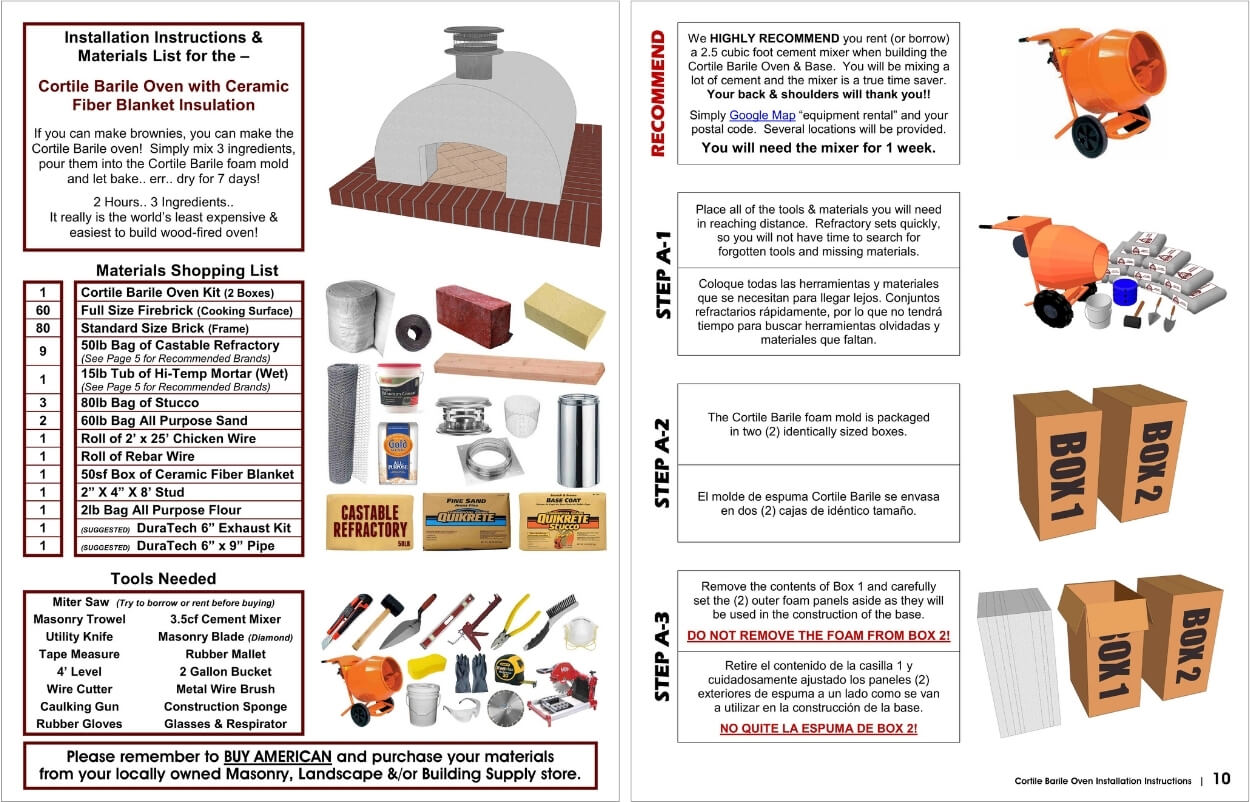
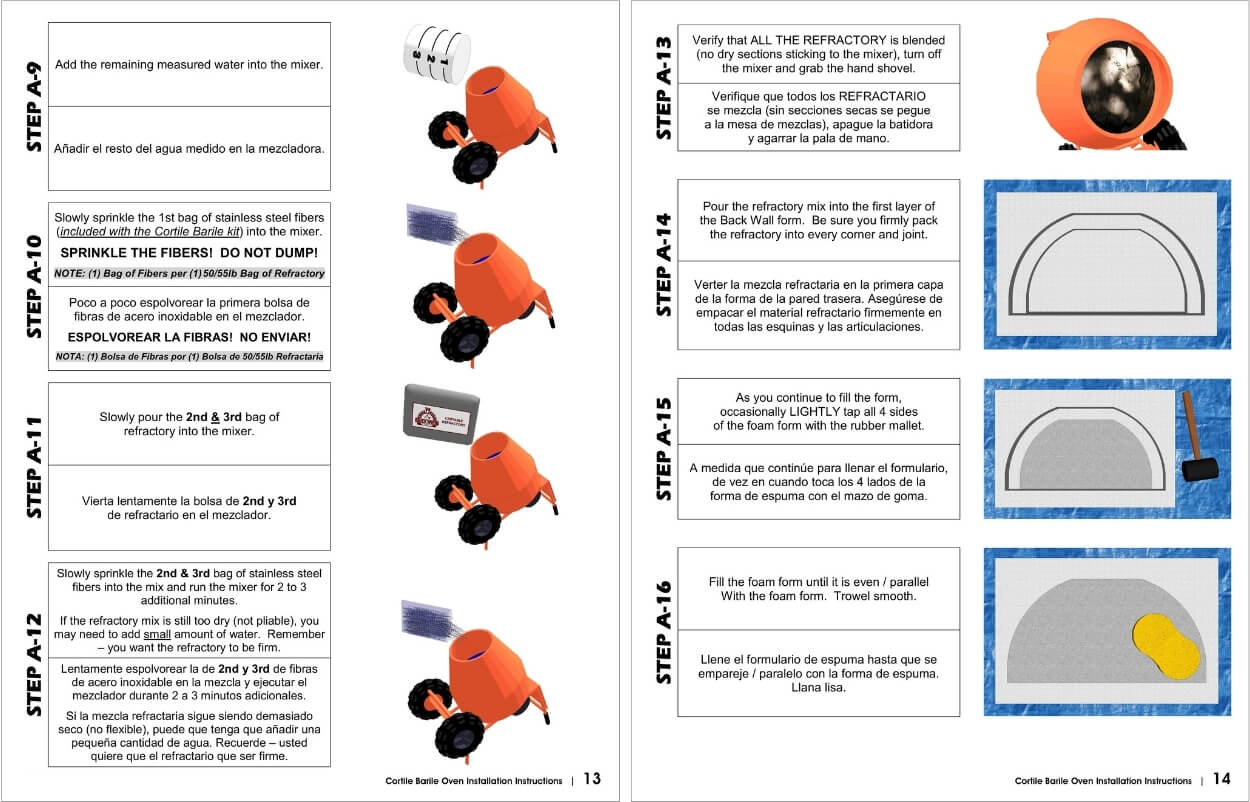
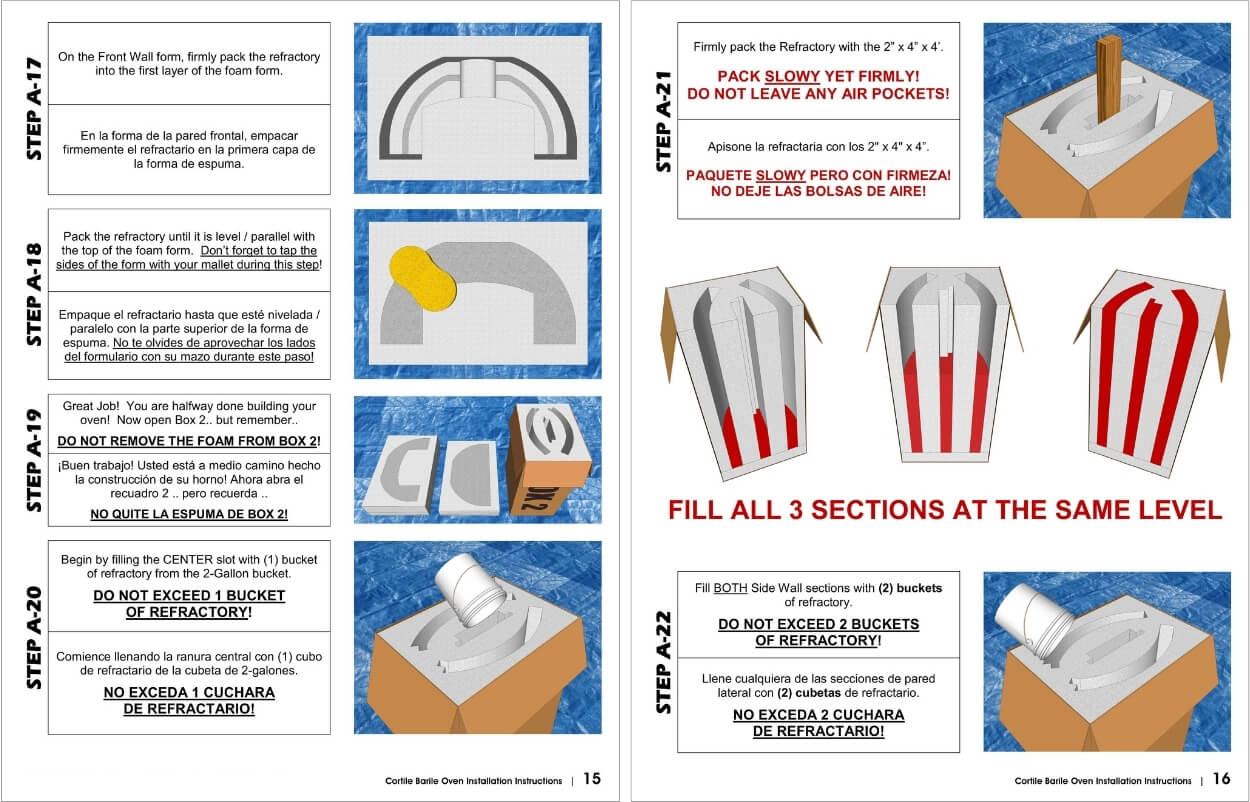
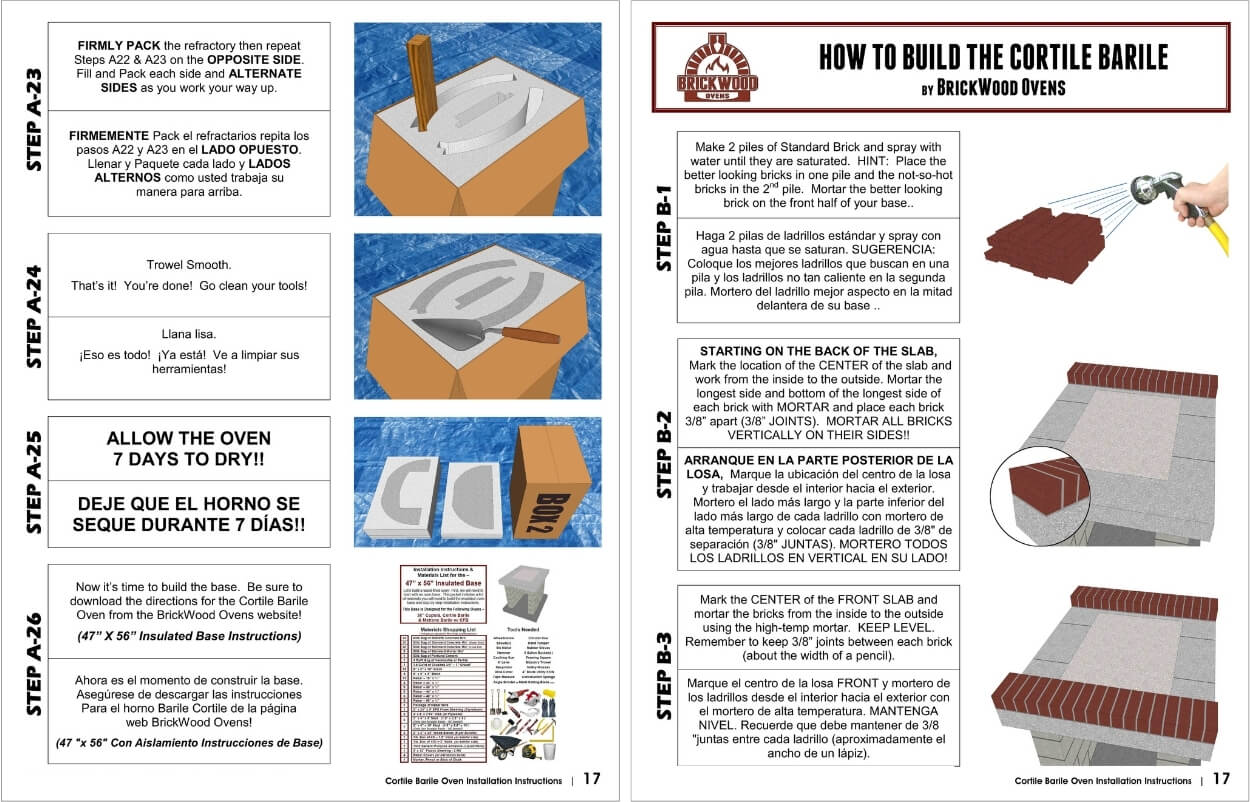
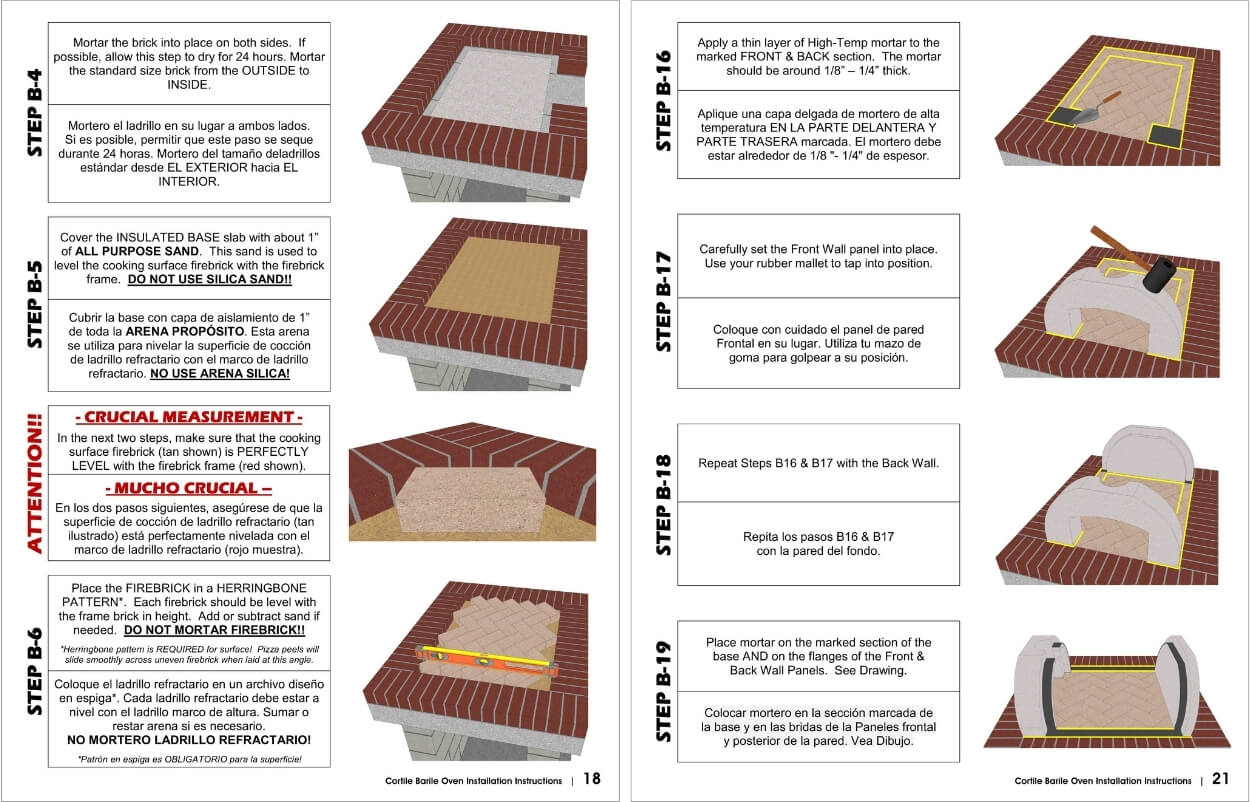
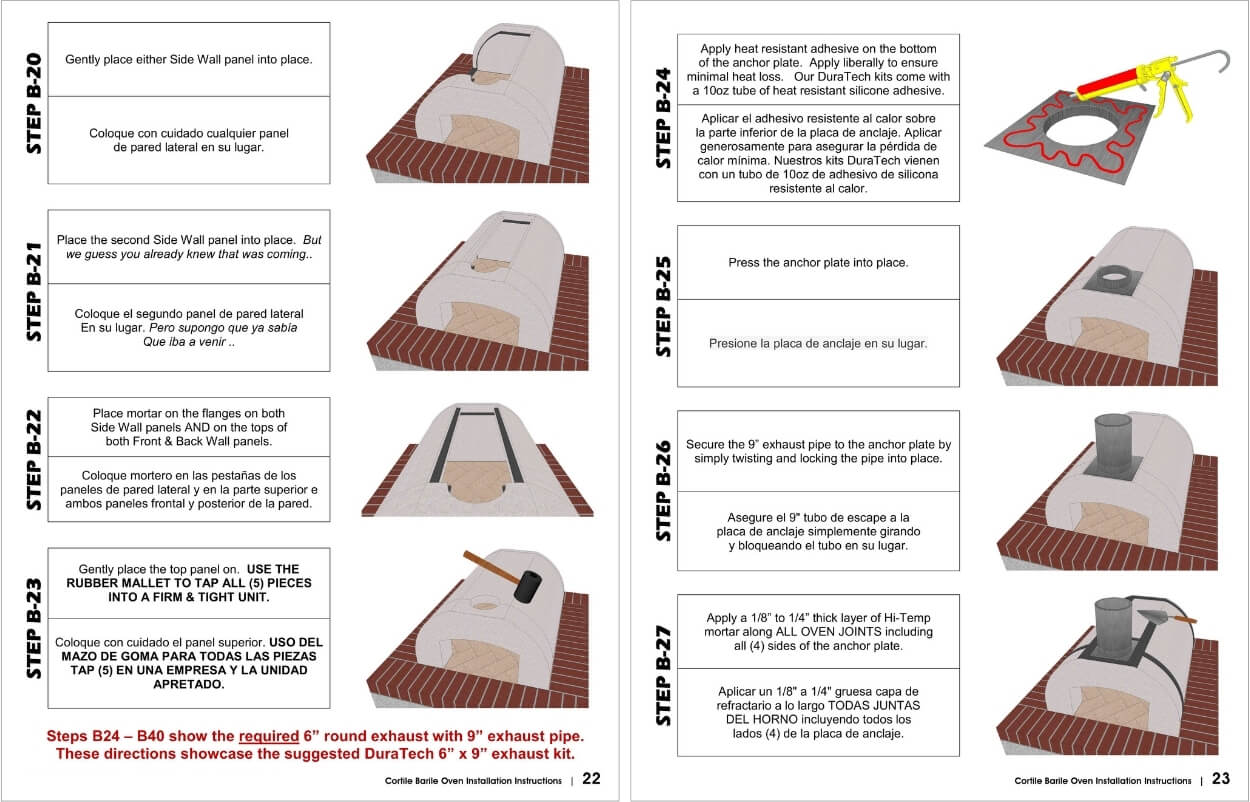
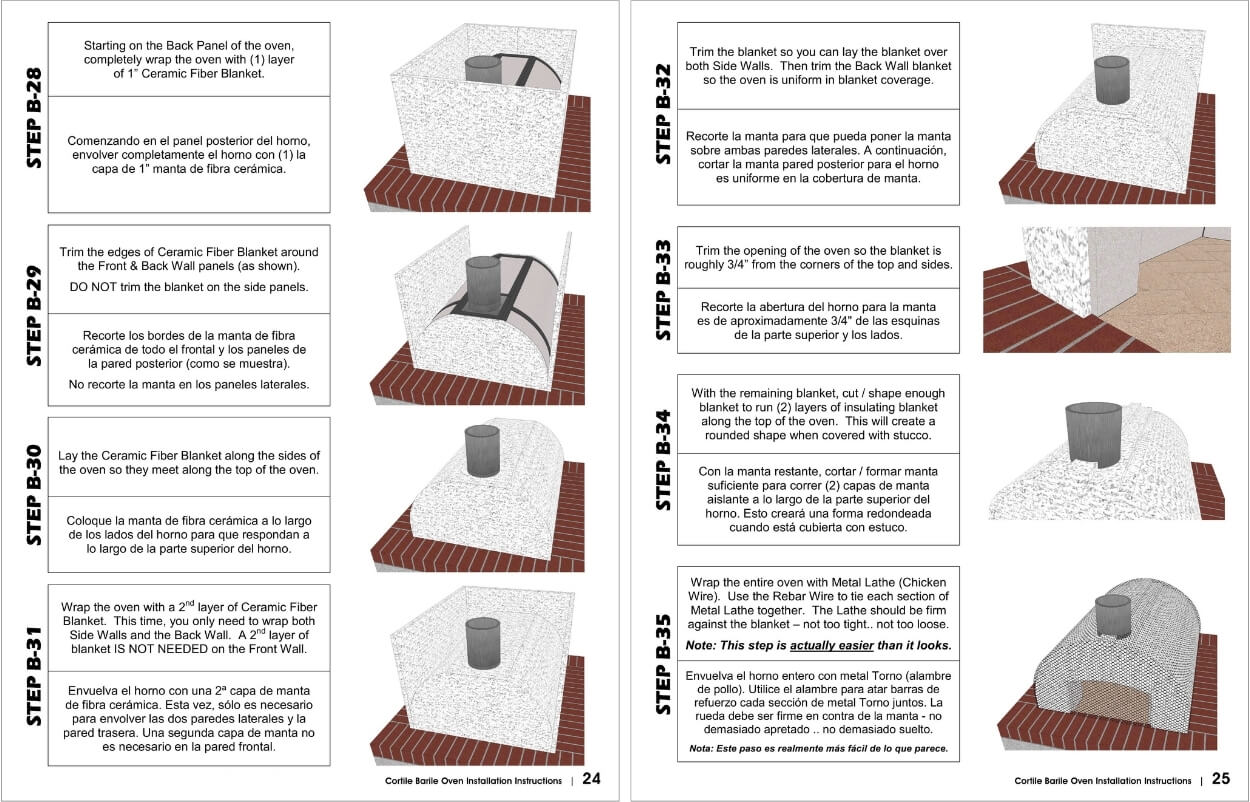
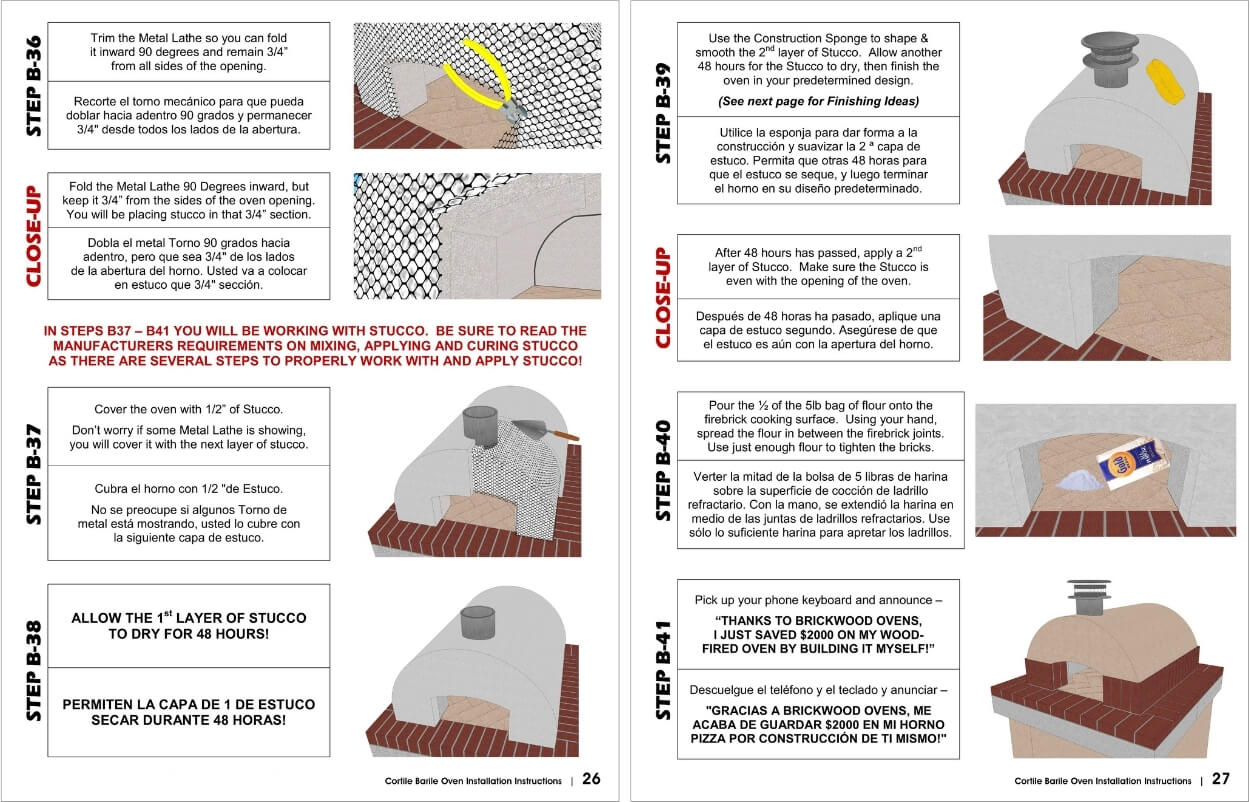
Pizza Oven Plans
Our FREE wood-fired pizza oven and pizza oven base plans have helped thousands of DIY enthusiasts create the backyard pizza oven of their dreams. Whether you're a seasoned mason or a complete novice, our colorful, detailed step-by-step plans, complete with exact materials lists, make it easy for homeowners to build a durable high-performance outdoor oven that will last for several generations.
Simply provide your email address below, and we’ll send you ALL of our DIY pizza oven and pizza oven base plans, along with precise materials lists, FREE of charge straight to your inbox. If you don’t see the email a few moments after clicking "SUBMIT," be sure to check your Spam or Promotions folders.








Simply provide your email address below, and we’ll send you ALL of our DIY pizza oven and pizza oven base plans, along with precise materials lists, FREE of charge straight to your inbox. If you don’t see the email a few moments after clicking "SUBMIT," be sure to check your Spam or Promotions folders.
Photo Gallery Reviews
View the Cortile Barile Gallery
Cortile Barile Gallery Reviews
View the entire Cortile Barile Gallery
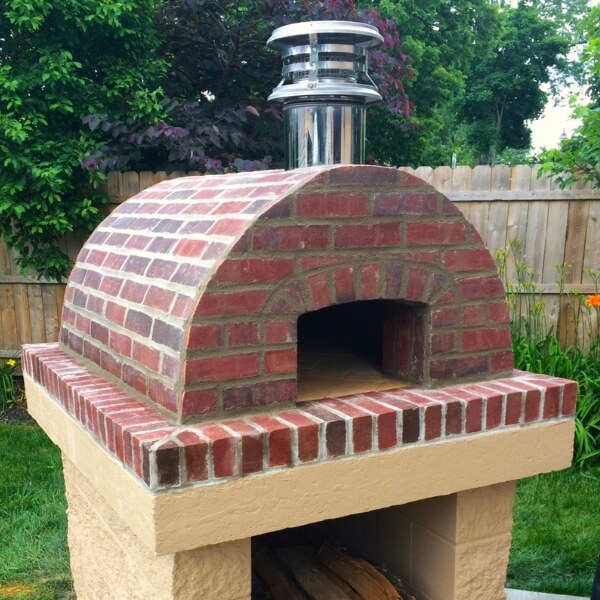
"Our Cortile Barile oven was a lot of fun to build! The pizza oven instructions were very straight forward, and all the materials were available within a few miles from home. The kids had a blast helping build the oven, and we all love to cook in it. I've already recommended BrickWood Ovens to a bunch of friends."
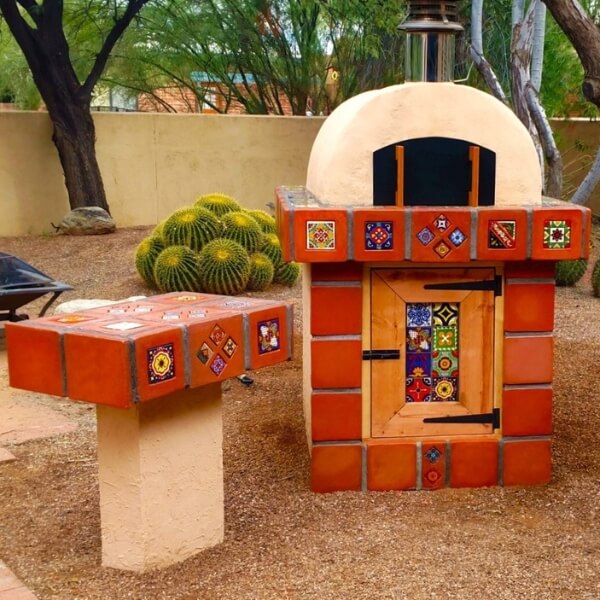
"Lorem ipsum dolor sit amet, consectetur adipiscing elit, sed do eiusmod tempor incididunt ut labore et dolore magna aliqua. Ut enim ad minim veniam, quis nostrud exercitation ullamco laboris nisi ut aliquip ex ea commodo consequat."
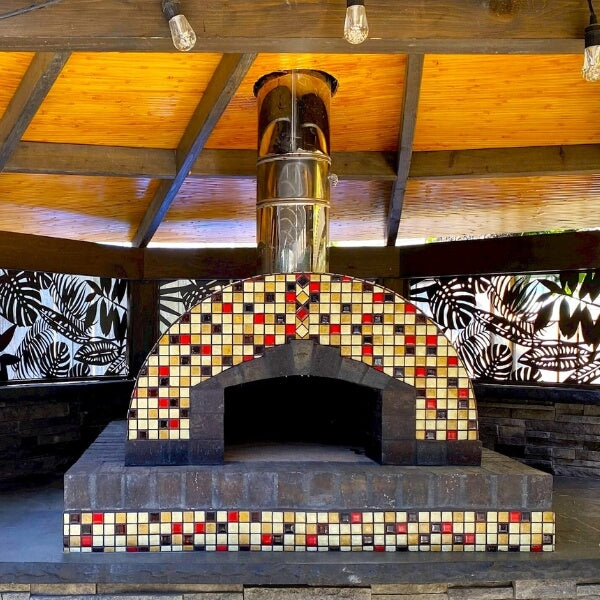
"Lorem ipsum dolor sit amet, consectetur adipiscing elit, sed do eiusmod tempor incididunt ut labore et dolore magna aliqua. Ut enim ad minim veniam, quis nostrud exercitation ullamco laboris nisi ut aliquip ex ea commodo consequat."
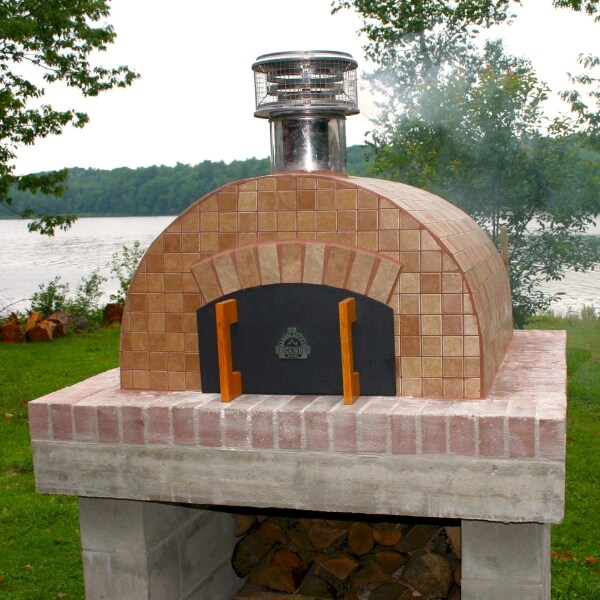
"Lorem ipsum dolor sit amet, consectetur adipiscing elit, sed do eiusmod tempor incididunt ut labore et dolore magna aliqua. Ut enim ad minim veniam, quis nostrud exercitation ullamco laboris nisi ut aliquip ex ea commodo consequat."
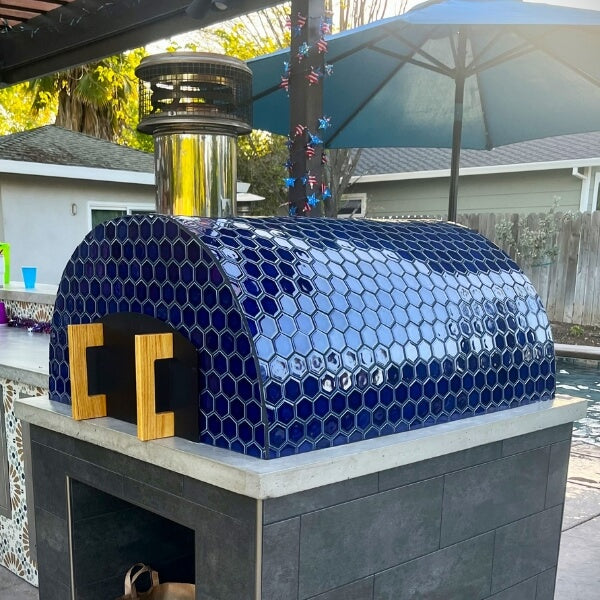
"Lorem ipsum dolor sit amet, consectetur adipiscing elit, sed do eiusmod tempor incididunt ut labore et dolore magna aliqua. Ut enim ad minim veniam, quis nostrud exercitation ullamco laboris nisi ut aliquip ex ea commodo consequat."
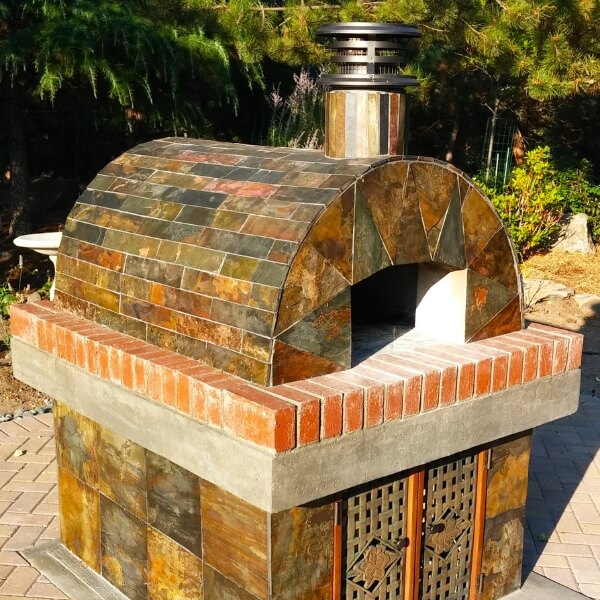
"We absolutely love our new wood fired oven and we couldn't be happier!"
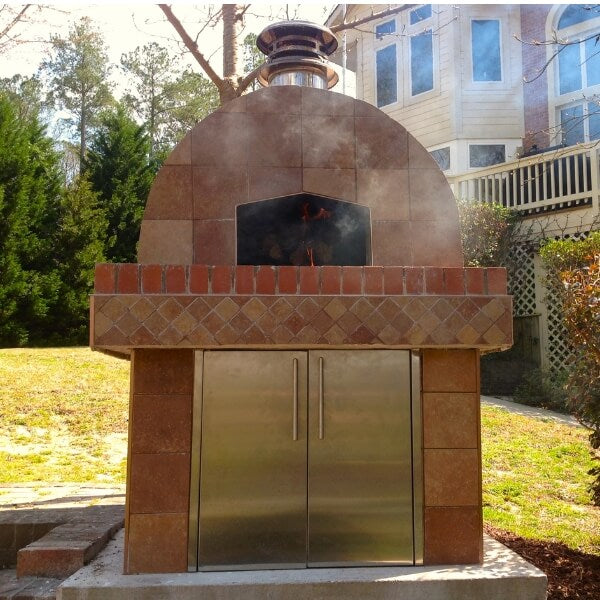
I purchased your pizza oven kit 2 years ago and the products exceeded all my expectations! Great instructions. Great materials / suppliers lists. This oven bakes the most wonderful products and fulfills that outdoors experience I crave. Love this pizza oven! Grade A+
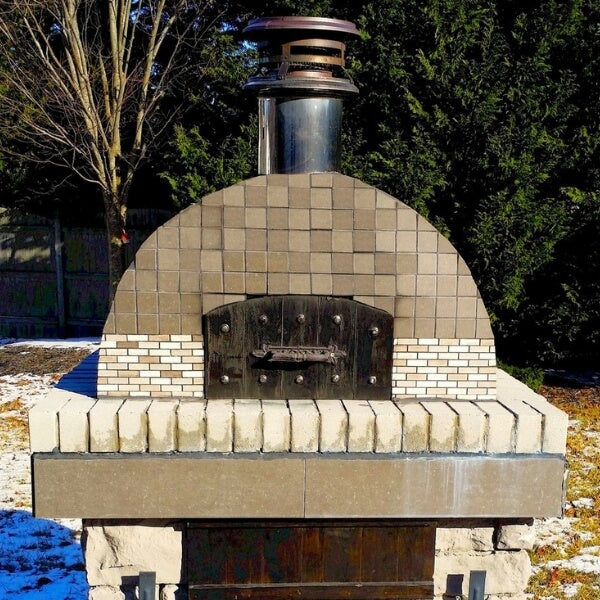
"Lorem ipsum dolor sit amet, consectetur adipiscing elit, sed do eiusmod tempor incididunt ut labore et dolore magna aliqua. Ut enim ad minim veniam, quis nostrud exercitation ullamco laboris nisi ut aliquip ex ea commodo consequat."
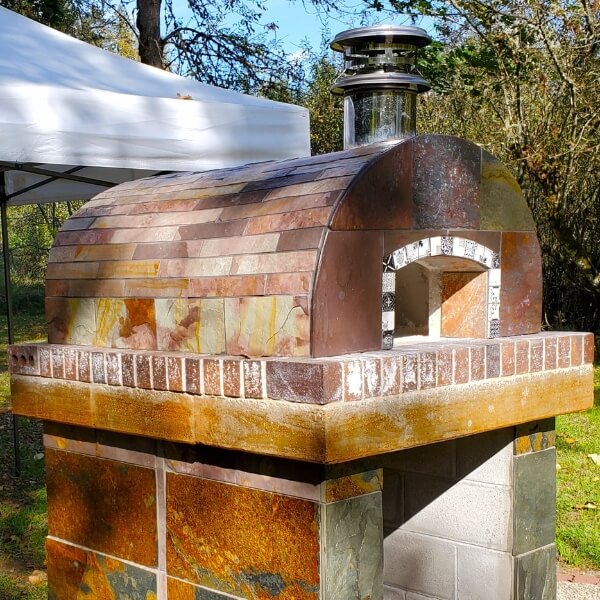
"Lorem ipsum dolor sit amet, consectetur adipiscing elit, sed do eiusmod tempor incididunt ut labore et dolore magna aliqua. Ut enim ad minim veniam, quis nostrud exercitation ullamco laboris nisi ut aliquip ex ea commodo consequat."
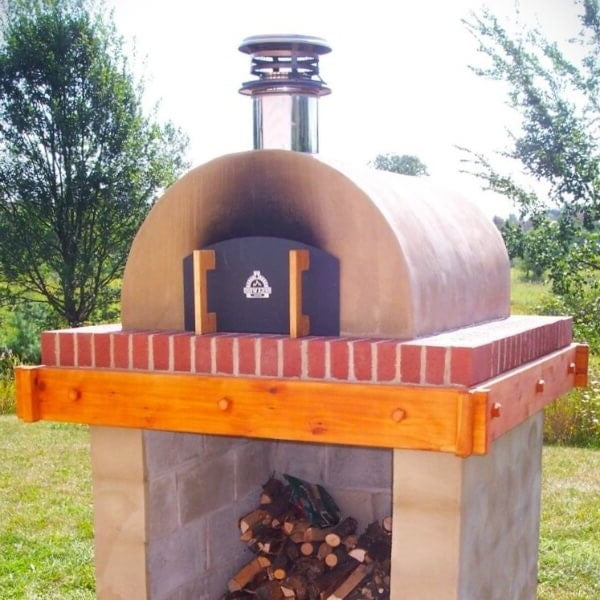
"I can't tell you how much we have enjoyed outdoor pizza oven. Our Cortile Barile is a great excuse to have family and friends over on a regular basis. It has performed flawlessly once the Chef (me) got the hang of it. Thank you for a GREAT wood fired pizza oven form."

"Lorem ipsum dolor sit amet, consectetur adipiscing elit, sed do eiusmod tempor incididunt ut labore et dolore magna aliqua. Ut enim ad minim veniam, quis nostrud exercitation ullamco laboris nisi ut aliquip ex ea commodo consequat."

"Lorem ipsum dolor sit amet, consectetur adipiscing elit, sed do eiusmod tempor incididunt ut labore et dolore magna aliqua. Ut enim ad minim veniam, quis nostrud exercitation ullamco laboris nisi ut aliquip ex ea commodo consequat."

"Lorem ipsum dolor sit amet, consectetur adipiscing elit, sed do eiusmod tempor incididunt ut labore et dolore magna aliqua. Ut enim ad minim veniam, quis nostrud exercitation ullamco laboris nisi ut aliquip ex ea commodo consequat."

"Lorem ipsum dolor sit amet, consectetur adipiscing elit, sed do eiusmod tempor incididunt ut labore et dolore magna aliqua. Ut enim ad minim veniam, quis nostrud exercitation ullamco laboris nisi ut aliquip ex ea commodo consequat."

"Lorem ipsum dolor sit amet, consectetur adipiscing elit, sed do eiusmod tempor incididunt ut labore et dolore magna aliqua. Ut enim ad minim veniam, quis nostrud exercitation ullamco laboris nisi ut aliquip ex ea commodo consequat."

"Lorem ipsum dolor sit amet, consectetur adipiscing elit, sed do eiusmod tempor incididunt ut labore et dolore magna aliqua. Ut enim ad minim veniam, quis nostrud exercitation ullamco laboris nisi ut aliquip ex ea commodo consequat."

"Lorem ipsum dolor sit amet, consectetur adipiscing elit, sed do eiusmod tempor incididunt ut labore et dolore magna aliqua. Ut enim ad minim veniam, quis nostrud exercitation ullamco laboris nisi ut aliquip ex ea commodo consequat."

"Lorem ipsum dolor sit amet, consectetur adipiscing elit, sed do eiusmod tempor incididunt ut labore et dolore magna aliqua. Ut enim ad minim veniam, quis nostrud exercitation ullamco laboris nisi ut aliquip ex ea commodo consequat."

"Lorem ipsum dolor sit amet, consectetur adipiscing elit, sed do eiusmod tempor incididunt ut labore et dolore magna aliqua. Ut enim ad minim veniam, quis nostrud exercitation ullamco laboris nisi ut aliquip ex ea commodo consequat."

"Lorem ipsum dolor sit amet, consectetur adipiscing elit, sed do eiusmod tempor incididunt ut labore et dolore magna aliqua. Ut enim ad minim veniam, quis nostrud exercitation ullamco laboris nisi ut aliquip ex ea commodo consequat."
Frequently Asked Fire Brick Questions
The Cortile Barile pizza oven distinguishes itself from other ovens on the market with our patented pour-and-pack foam pizza oven forms. This innovative 5-piece oven kit is made by pouring and packing castable refractory material into molds crafted from expanded polystyrene (EPS), often referred to as "Styrofoam," which is a trademarked brand name synonymous with EPS. After pouring and packing the castable refractory, a process that takes about 90 minutes, you allow it to cure for a week. Once fully cured, you can remove the foam, revealing the five pieces needed to construct the pizza oven: front, back, left side, right side, and top. When these pieces are bonded together and finished with your choice of exterior, you'll have a durable, long-lasting wood-fired pizza oven designed to last for generations
The construction method of this oven is similar to our dome-shaped 28" Mattone Cupola pizza oven, which also uses castable refractory poured and packed onto an EPS foam mold. While both the Cortile Barile and Mattone Cupola share similar functionality and materials (and use the same size pizza oven base), the round hearth and extra thick walls of the Mattone Cupola require an additional 260 lbs of castable refractory. This makes the Mattone Cupola ideal for extended baking sessions, whether all day or throughout the weekend. In contrast, the Cortile Barile is designed for quick heating, offering an authentic wood-fired oven experience for parties or events lasting 4 to 5 hours, as well as casual family nights with friends.
The Cortile Barile pizza oven kit and the Mattone Cupola pizza oven kit share similarities in construction and functionality, excelling at baking low-profile foods like breads and pizzas. However, the Cortile Barile offers a more straightforward assembly process compared to the Mattone Barile series of DIY pizza oven kits, which require more fire brick, high-temperature refractory mortar, and a greater investment of time and elbow grease. In addition to the differences in labor intensity, there are functional distinctions between the two. Both the Cortile Barile and Mattone Cupola feature a smaller oven opening and a low ceiling made of heat-retaining castable refractory. This design enhances their ability to cook low-profile foods efficiently, requiring minimal fuel while providing excellent heat retention for dishes like bread, pizzas, casseroles, and skillet dinners. Whereas the Mattone Barile series pizza ovens are designed with a larger front opening and a 19" ceiling. This design not only allows for cooking and baking low-profile foods but also accommodates larger items like turkeys and wood-fired BBQ, making them versatile for a wide range of culinary creations.
Do I need any masonry experience to build a Cortile Barile or any of your oven kits?
When we founded BrickWood Ovens, our mission was clear: to create pizza oven kits that anyone, regardless of masonry experience, could use to build a high-performance wood-fired oven while staying on (or preferably below) budget. We went the extra mile by developing detailed, colorfully illustrated plans for both the pizza oven and its base, complete with materials lists. Best of all, we offer these pizza oven plans for free, so you can download them before ordering your kit and see just how simple it is to construct a pizza oven for your family using locally sourced masonry materials.
We’ve received hundreds of 5-star reviews from customers who built their dream pizza ovens without any technical training. And we've received just as many reviews expressing gratitude for the skills, knowledge and confidence our customers gained while building their ovens from scratch which empowered them to take on additional masonry projects around their homes.
What is the average cost of a fully built Cortile Barile (oven & base)?
The estimated cost for a standard Cortile Barile oven build, including the base, ranges from approximately $2800 to $3000. This estimate includes the Cortile Barile • Package 1 kit (Foam Molds, Stainless Exhaust Kit with Pipe and Ceramic Fiber Blanket).
How much does a fully built Cortile Barile weigh?
A fully assembled Cortile Barile, encased with two layers of stucco and a thin-brick veneer, weighs between 800 and 1000 lbs. This weight does not include the fire brick hearth. If you include the fire brick cooking surface, that adds an additional 375 lbs. In total, the finished Cortile Barile oven, the fire brick hearth, the concrete hearth slab, and the cinderblock base (excluding the concrete base slab), has a weight just north of 2000 lbs.
What materials do I need to build the Cortile Barile and where do I buy them?
First, you’ll want to choose the Cortile Barile pizza oven kit that’s perfect for you. The Cortile Barile Foam Forms provide the molds and stainless steel fibers that you mix with the castable refractory. The Cortile Barile • Package 1 includes these forms and fibers, along with a high-end, double-walled stainless steel exhaust kit and one box of ceramic fiber blanket. The Cortile Barile • Package 2 builds on this, adding the optional pizza oven door and tools (which you can always order later). And the Cortile Barile • Package 3 includes everything in Package 2, plus castable refractory and fire brick, all delivered to your home or job site at no extra cost.
After receiving our email with your FREE pizza oven plans, download and print the Cortile Barile Pizza Oven and Cortile Barile Pizza Oven Base plans (PDFs). The first page of each plan set includes detailed materials lists for both the oven and the base. Rest assured, the plans are precise down to the last nail!
As you review the materials lists, you may come across some items that are unfamiliar, such as castable refractory or refractory mortar. Many of these materials aren't available at big box hardware stores but can be found at your local landscape or masonry supply stores (the go-to masonry supply stores for professionals). To help you find your local landscape and masonry dealers, along with a list of refractory manufacturers and suppliers, visit our Landscape | Masonry Supply Stores & Refractory Supply Stores directory. Simply enter your zip code to discover nearby stores where you can source all the materials needed to build your Cortile Barile pizza oven and base.
Before purchasing your materials, be sure to check out our forum post: Money Saving Tips when Working with Landscape and Masonry Supply Stores and/or Refractory Manufacturers and Dealers. This informative article can literally save you hundreds of dollars on your pizza oven project.
What does a damper do and how does it help the performance of my oven?
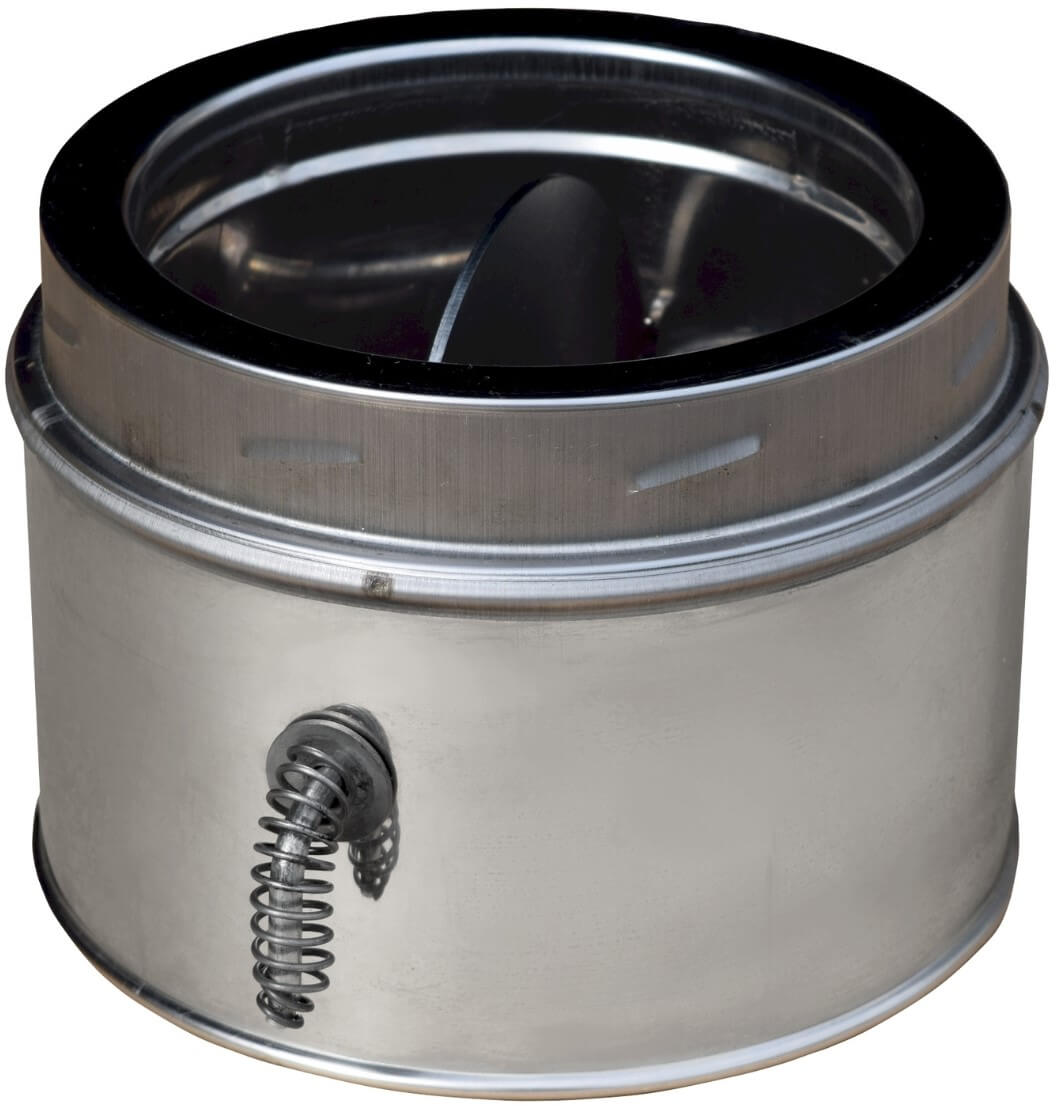

A chimney damper is a device installed in our 6" x 6" chimney pipe that regulates airflow. Its main purpose is to open and close the pipe, controlling the draft when the pizza oven is in use or not. When the damper is open, smoke, gases, and heat can escape from the oven. When closed, it prevents heat from escaping once the oven reaches its optimal cooking temperature.
A chimney damper is a device installed in our 6" x 6" chimney pipe that regulates airflow. Its main purpose is to open and close the pipe, controlling the draft when the pizza oven is in use or not. When the damper is open, smoke, gases, and heat can escape from the oven. When closed, it prevents heat from escaping once the oven reaches its optimal cooking temperature. When used in conjunction with a pizza oven door, a closed damper effectively seals the oven, maintaining the high temperatures inside. Additionally, a closed damper helps keep out debris, animals, and cold air, which can lead to inconsistent baking temperatures.
When used in conjunction with a pizza oven door, a closed damper effectively seals the oven, maintaining the high temperatures inside. Additionally, a closed damper helps keep out debris, animals, and cold air, which can lead to inconsistent baking temperatures.
When used in conjunction with a pizza oven door, a closed damper effectively seals the oven, maintaining the high temperatures inside. Additionally, a closed damper helps keep out debris, animals, and cold air, which can lead to inconsistent baking temperatures.
Our 6in stainless steel, double-wall damper fits between the 6" x 12" chimney pipe and the chimney cap. To install, simply place the damper on top of the chimney pipe and twist it into position. Then, attach the chimney cap to the top of the damper using the same method. When you want to retain heat in your oven, simply turn the handle on the damper to the "closed" position. This action moves a round metal plate inside the damper, sealing off the interior and preventing heated air from escaping the oven, helping to maintain the oven’s temperature.
You recommend ordering an additional box of Ceramic Fiber Blanket. What are the benefits?
Ceramic fiber blanket (6lb) is a high-temperature insulation material designed to withstand extreme heat, making it ideal for kilns, furnaces, and pizza ovens. It effectively traps air within its fibrous structure, minimizing heat transfer and creating a barrier between your oven's intensely heated interior and the cooler exterior. The more layers of ceramic fiber blanket (CFB) you add, the better insulated your oven becomes. This results in needing less firewood to reach temperature, achieving high cooking temperatures more quickly, extending cooking times before needing to refire the oven, and keeping the exterior of your pizza oven significantly cooler to the touch.
One box of 6lb ceramic fiber blanket provides enough material to wrap your Cortile Barile pizza oven with two layers of insulation. By purchasing an additional box, you can add another 1.5 to 2 layers, further enhancing your oven's efficiency and performance. If you're looking to significantly maximize the capabilities and performance of your pizza oven, consider adding a box of 8lb ceramic fiber blanket. While it may cost a bit more, this upgrade offers improved efficiency for your oven. To put it in perspective, think of the standard 6lb CFB as a Corvette, while the 8lb CFB is akin to a Ferrari (slightly better performance / slightly more expensive). Just remember to apply the 8lb blanket to your oven before adding the 6lb blanket for the best results.
Why does the Ceramic Fiber Blanket arrive a few days before or after my oven kit?
Your ordered products may arrive on different days due to our shipping processes and the availability of items in our warehouse. For example, items like the Ceramic Fiber Blanket are sourced from our refractory partners nearest to your location, allowing us to reduce shipping costs and pass those savings on to you. While we strive to deliver your products as quickly as possible, some items may be shipped separately based on their location or shipping method thus arriving at your location on different days.
Can you send me specific plans on an oven I saw in your photo gallery?
All the stunning pizza ovens featured in our photo galleries were built using a BrickWood pizza oven kit along with our free pizza oven plans. With these plans, BrickWood customers were able to construct high-performance wood-fired pizza ovens from the ground up using locally sourced masonry materials. While we guide you through building a base and oven with a simple yet stylish finish, by the time you reach this stage, you'll have gained the skills and knowledge to personalize your oven and base with your own artistic flair. Every unique pizza oven showcased in our gallery was designed and crafted by its builder, reflecting their individual creative vision.
We frequently receive inquiries such as, "Can you put me in contact with the builder of XXX oven? I have some questions about their oven." We apologize, but we cannot provide our customers' contact information to anyone, just as we would never share your contact information. You’re welcome to visit the BrickWood Forum, where many of our customers share their experiences and discuss the construction processes involved in building their BrickWood ovens. There are numerous members who are more than happy to offer advice on constructing your DIY pizza oven.
More questions? See our Expanded FAQ Page or visit the BrickWood Forum


